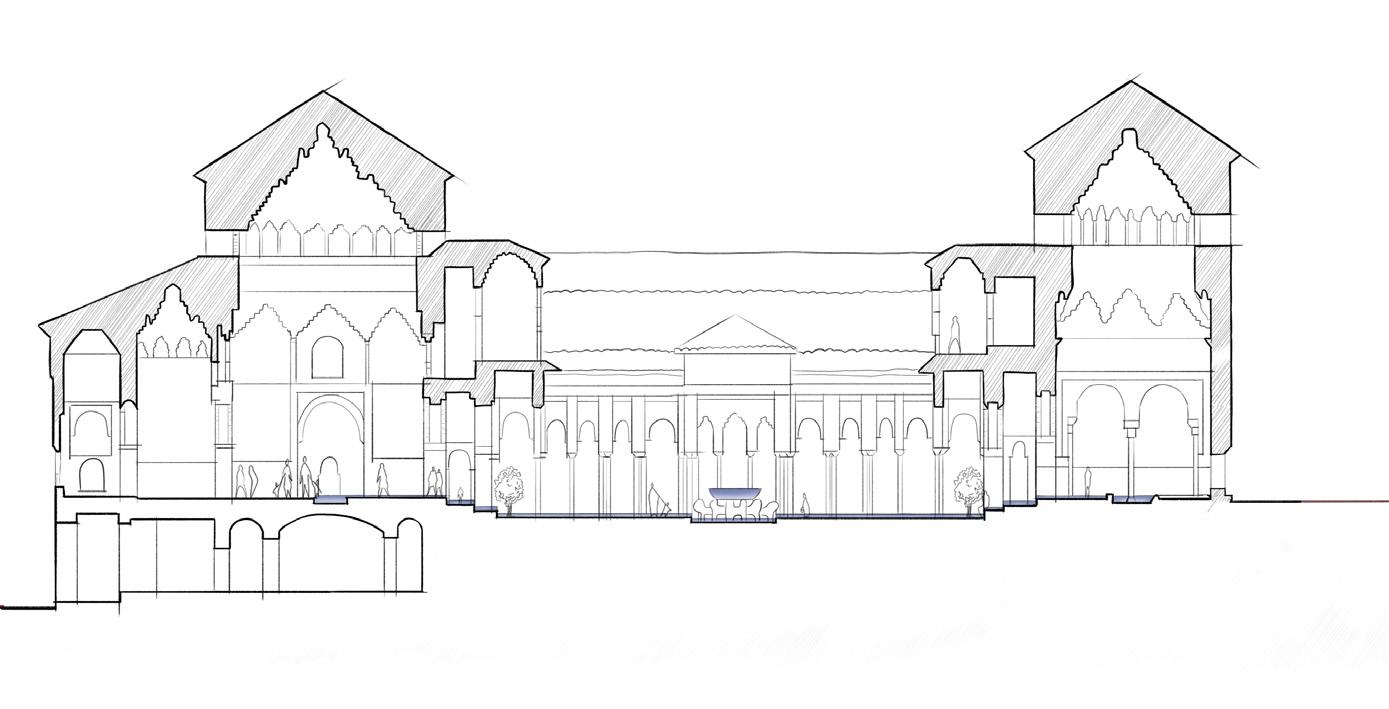
Architecture Portfolio 2024
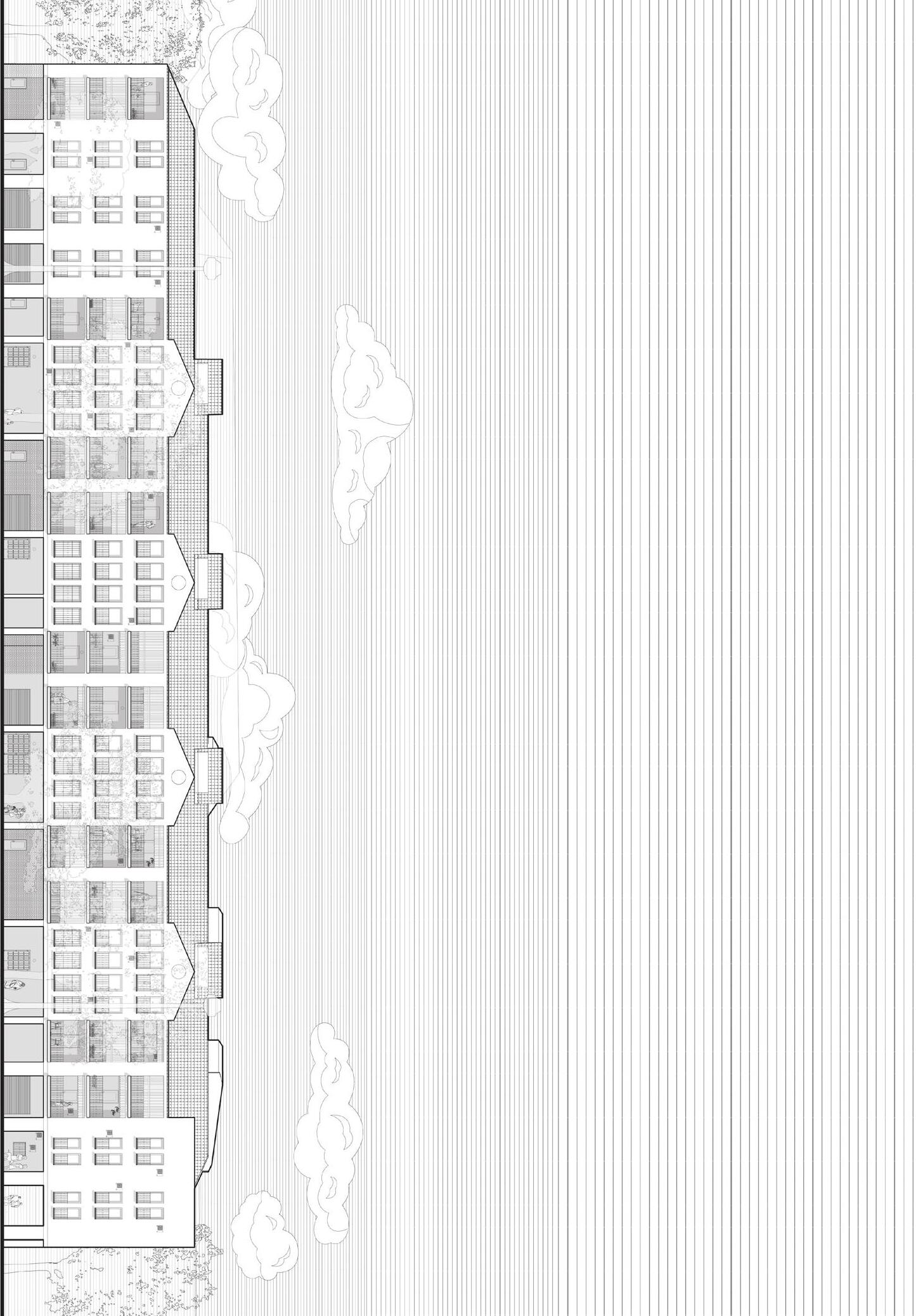
01. Vernacular Resilience Undergraduate Thesis
02. Concrete Jungle Student Commons Pavilion


Architecture Portfolio 2024

01. Vernacular Resilience Undergraduate Thesis
02. Concrete Jungle Student Commons Pavilion
SUSTAINABLE REHABILITATION
My thesis aims to re-purpose misused mini-blocks in Andalucía by creating sustainable residential complexes that incorporate culture and contemporary environmental engineering techniques. The research will focus on studying the Alhambra palace in Granada and different superblock systems, analyzing climate data and change predictions, and delving into Andalucía’s cultural and economic sectors.
The project involves designing a modified mini-block that showcases how to re-purpose misused blocks in a sustainable and aesthetically pleasing manner. State-ofthe-art sustainable technologies will be innovated with an emphasis on local climate, culture, human experience, and Andalusian vernacular architecture. The goal is to create a balance between aesthetic appeal, culture, and sustainability while reducing energy consumption and creating renewable energy. The design will be functional, sustainable, and culturally seamless.
Undergraduate Thesis
Instructor: Nicholas Hoban
Date of completion: Winter 2023
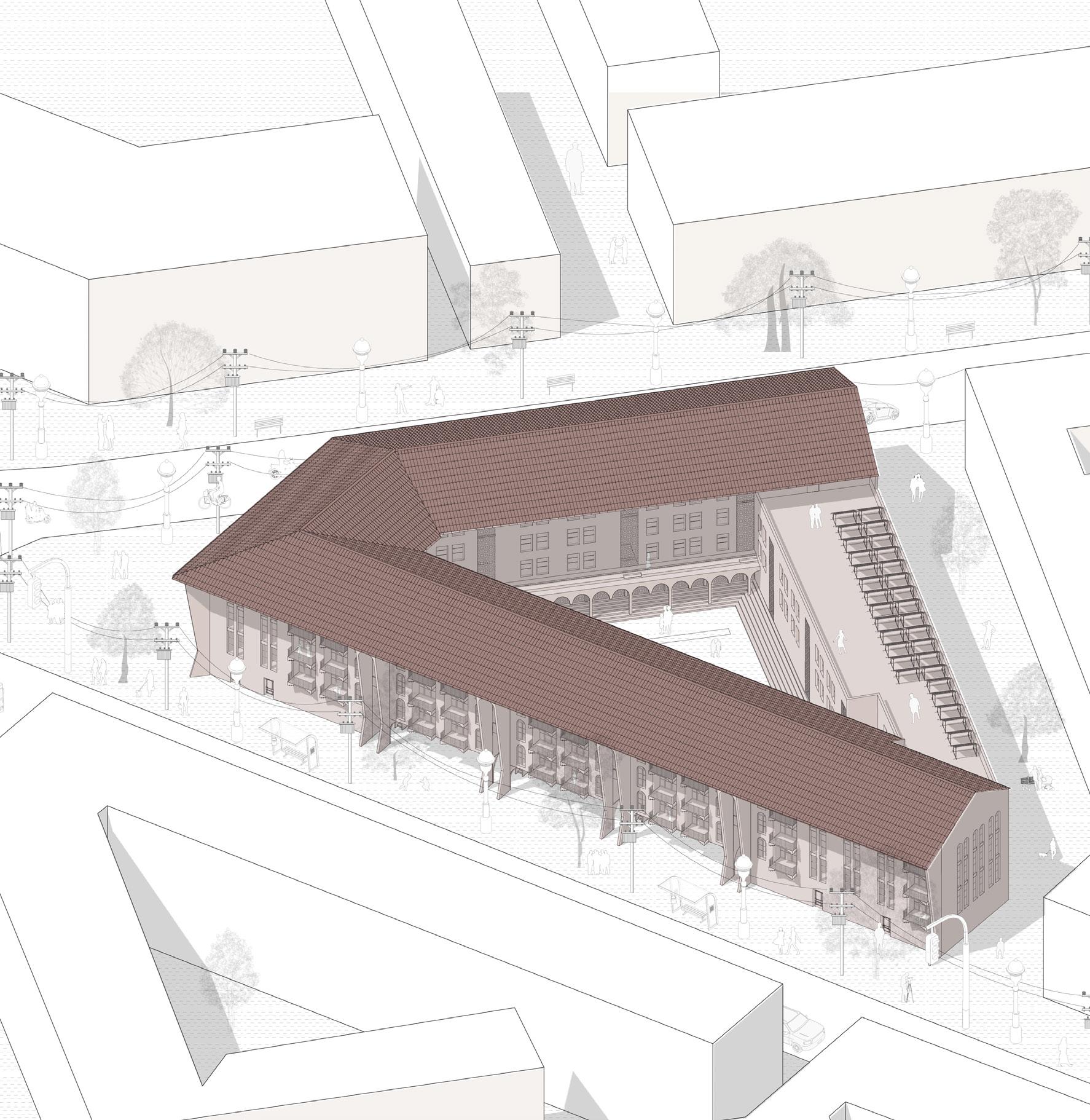
The Alhambra palace employs passive cooling and heating through strategic placement, thick insulated walls, shaded porticos, and airflow-friendly openings. Marble-lined walls and gardens with over 600 plant species enhance thermal stability and evaporative cooling. Architectural elements like mocárabes and mashrabiyas offer both decoration and thermal control, while courtyards are oriented to maximize radiant cooling and airflow.
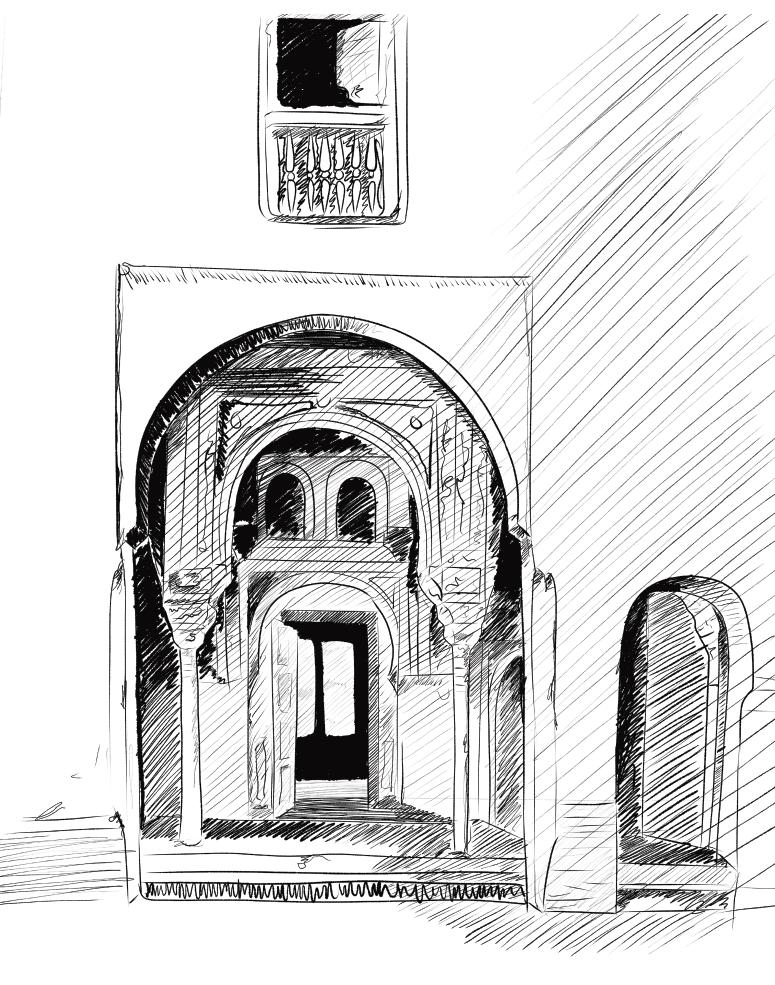
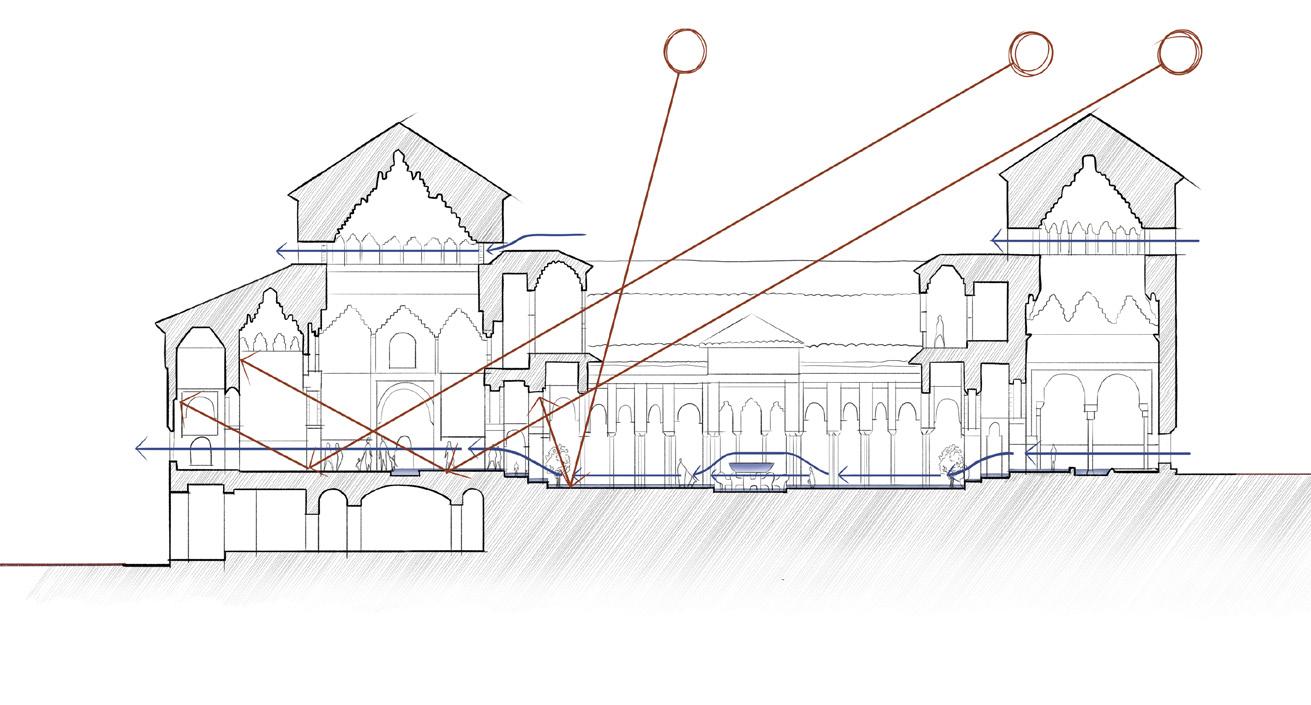
Site model 1:100
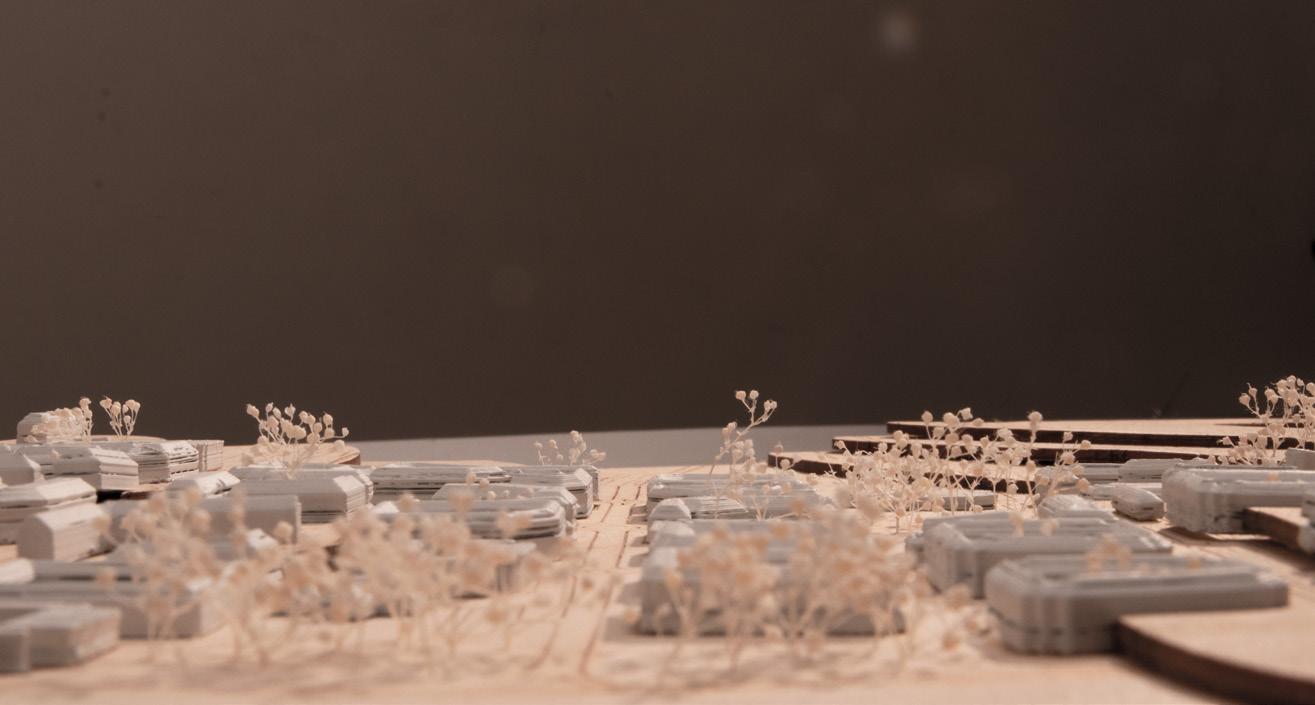
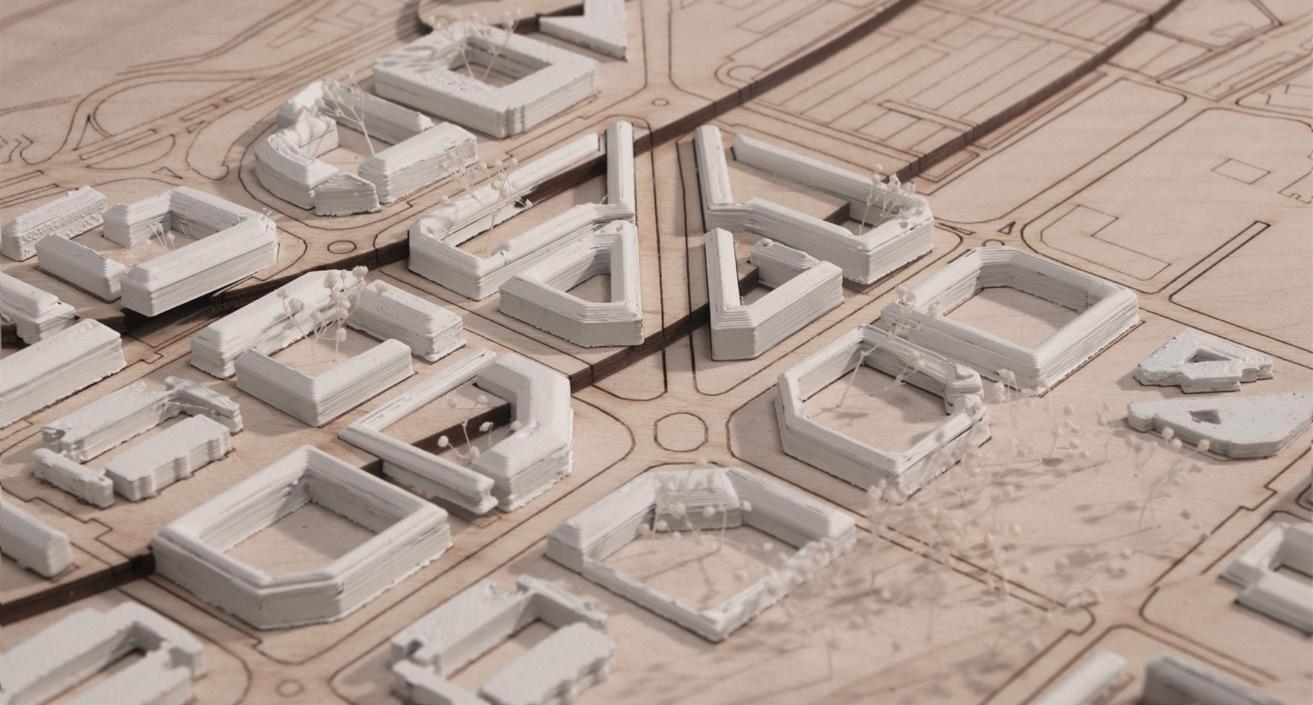
Built in 1982 as social housing in Córdoba, Spain, the Polígono del Guadalquivir faced criticism for poor construction and low energy efficiency, with most buildings rated G. Despite the area’s economic role, it struggles with poverty, overcrowding, and substandard living conditions.
Government efforts provide housing programs and social services, but issues remain, including high energy costs, poor ventilation, and health concerns from inadequate heating and construction.
To approach the Poligono del Guadalquivir’s issues, I decided to focus on one specific mini-block. This is Block 15. Much like the other blocks, it has an enclosed courtyard with no greenery, poor construction and insulation and it is very rundown. The block comprises of 4 floors, the first of which is for commercial purposes and the other three for residential.
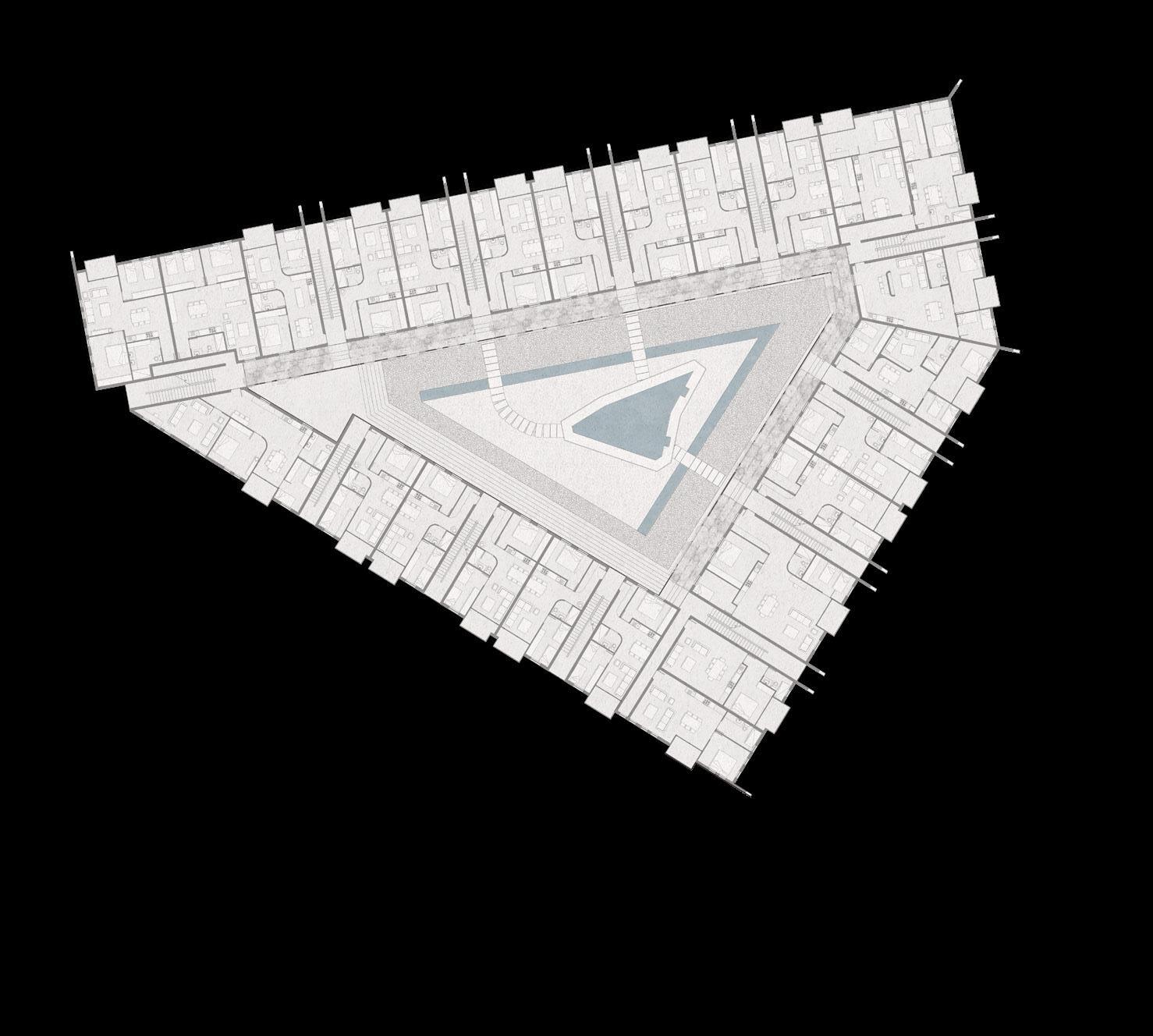
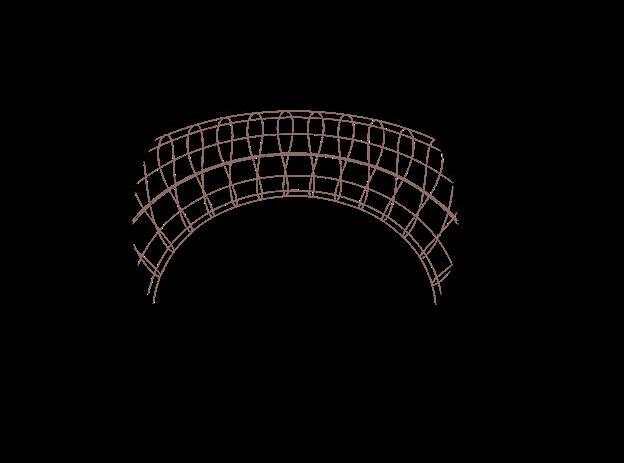
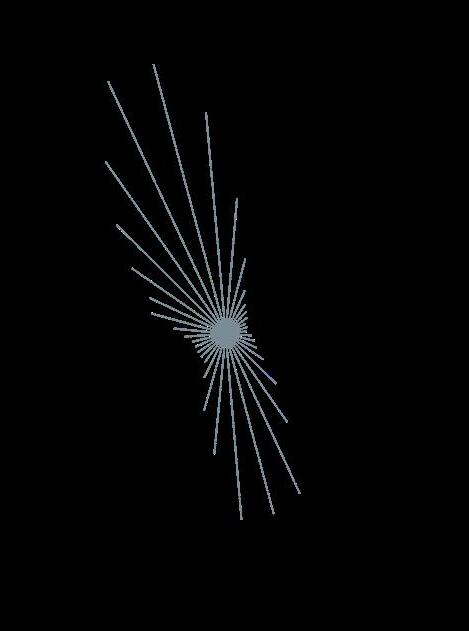
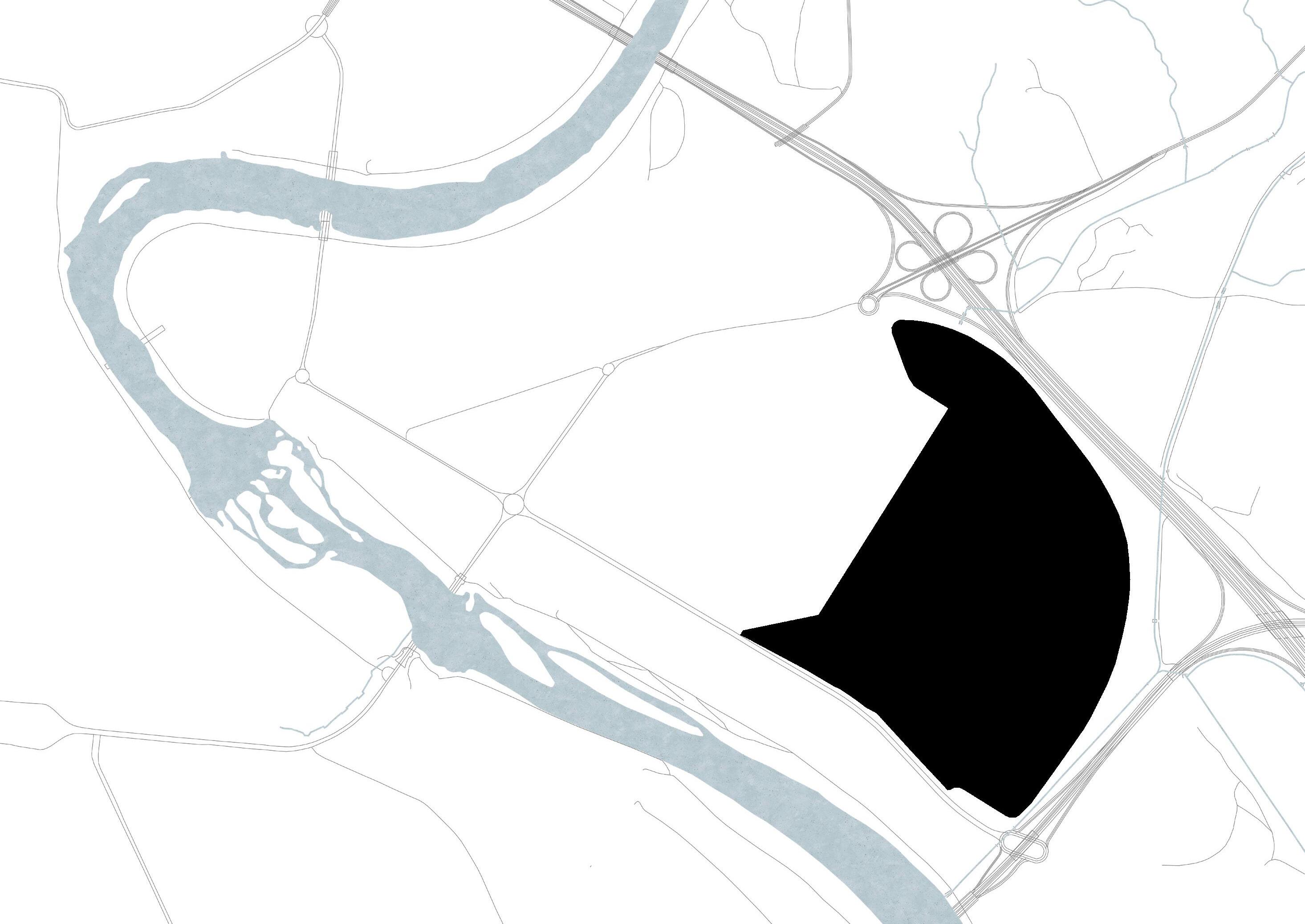
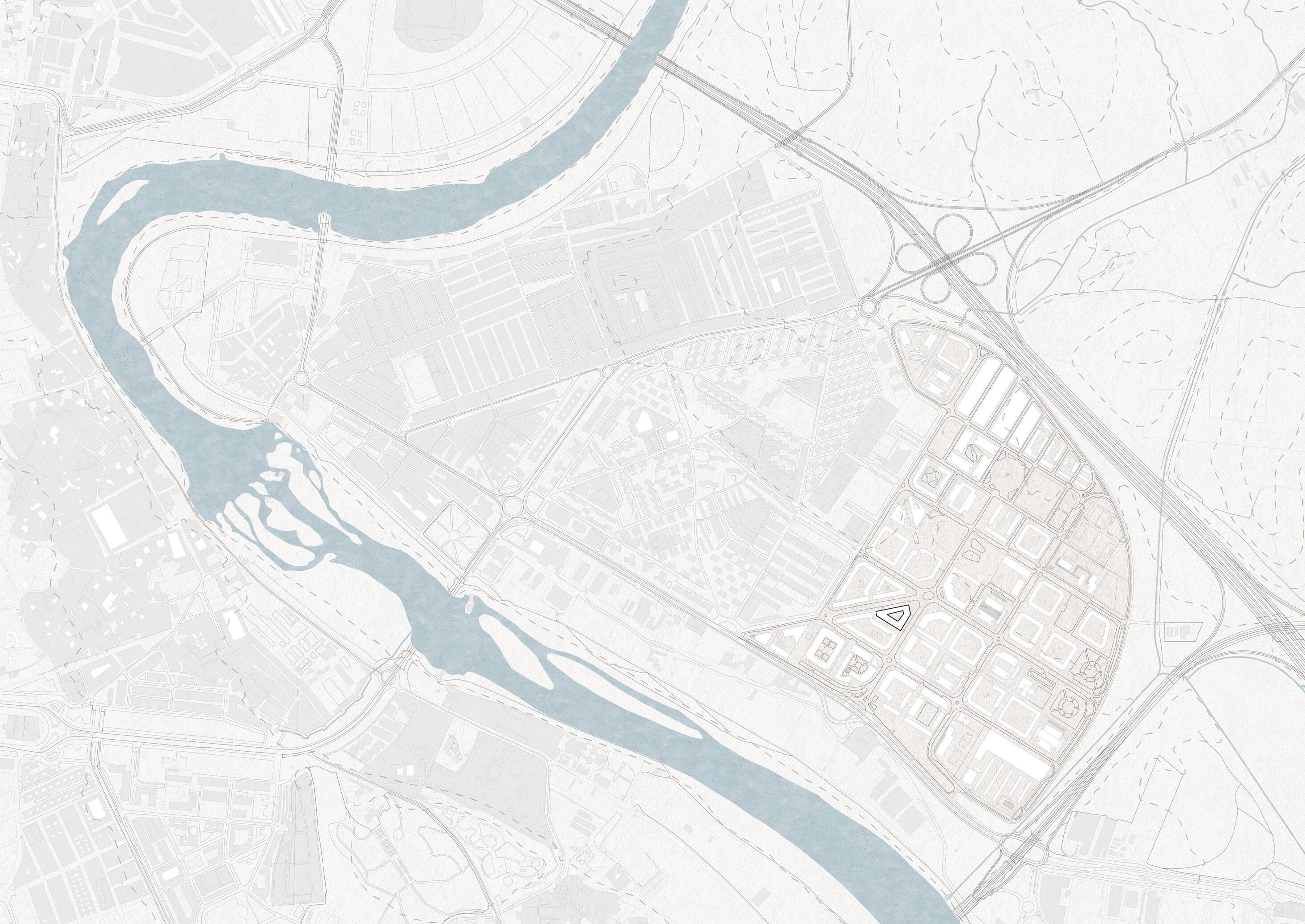


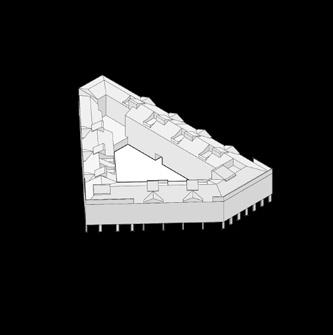
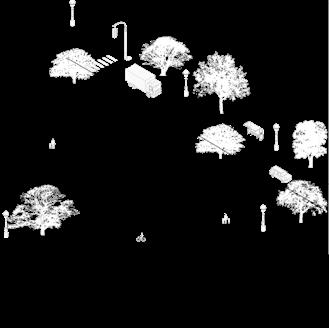

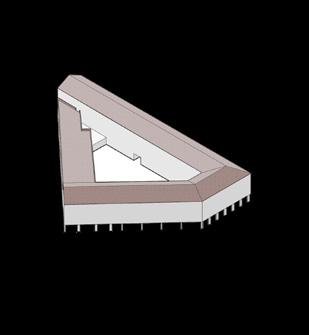

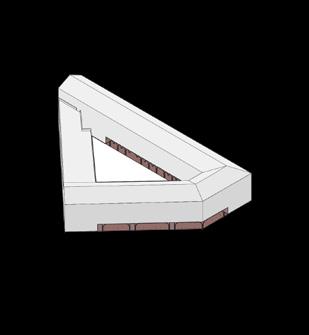

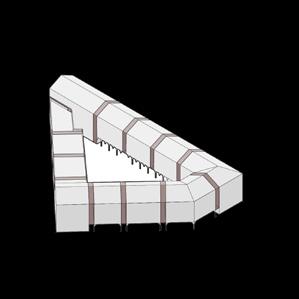



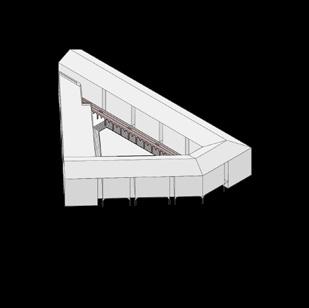
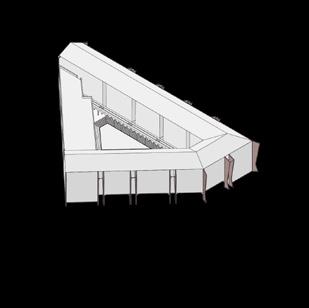


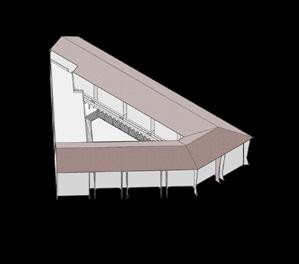


Air currents can be generated by removing parts of the ground floor, thereby facilitating the cooling of the area. However, it is important to maintain adequate space for the residents.
The enclosed commercial spaces on the ground floor will be transformed into outdoor markets, which can serve as venues for local artisanry and events, and contribute to the cooling of the building.
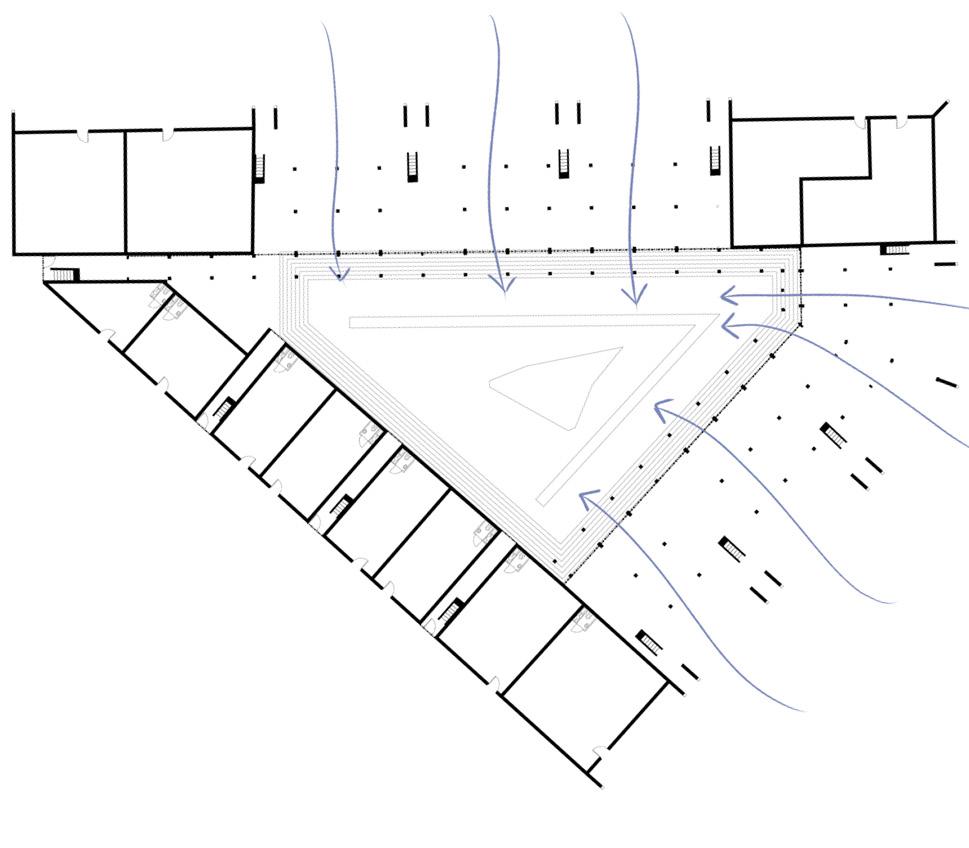
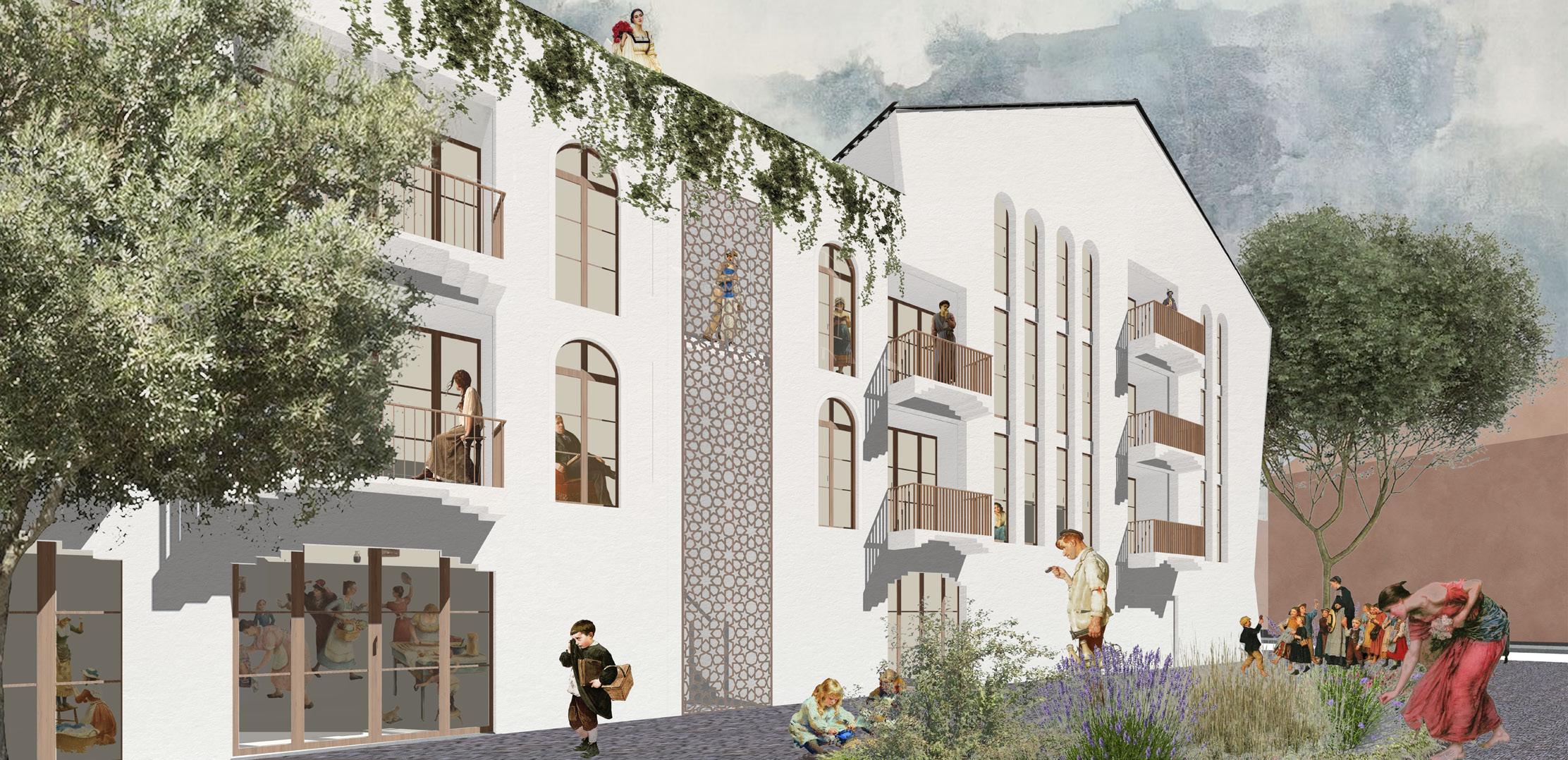



To block direct sunlight during the hottest hours of the day, the design includes openings and extended roof structures, which allow light to enter the space when it’s not as strong. Overall, the design incorporates similar strategies as the Alhambra to provide a comfortable and cool space.

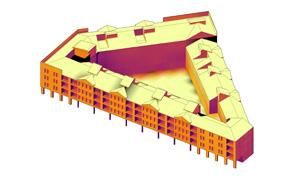
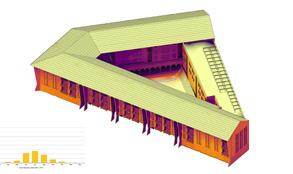
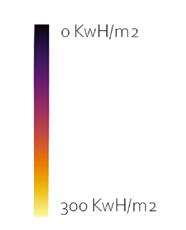
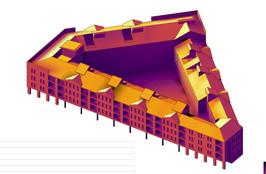
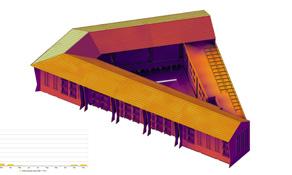
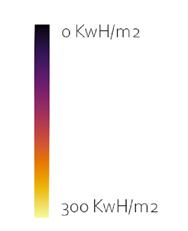
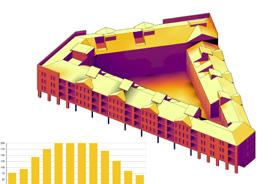
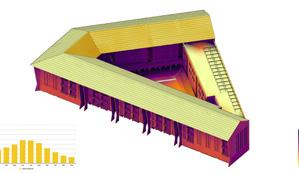
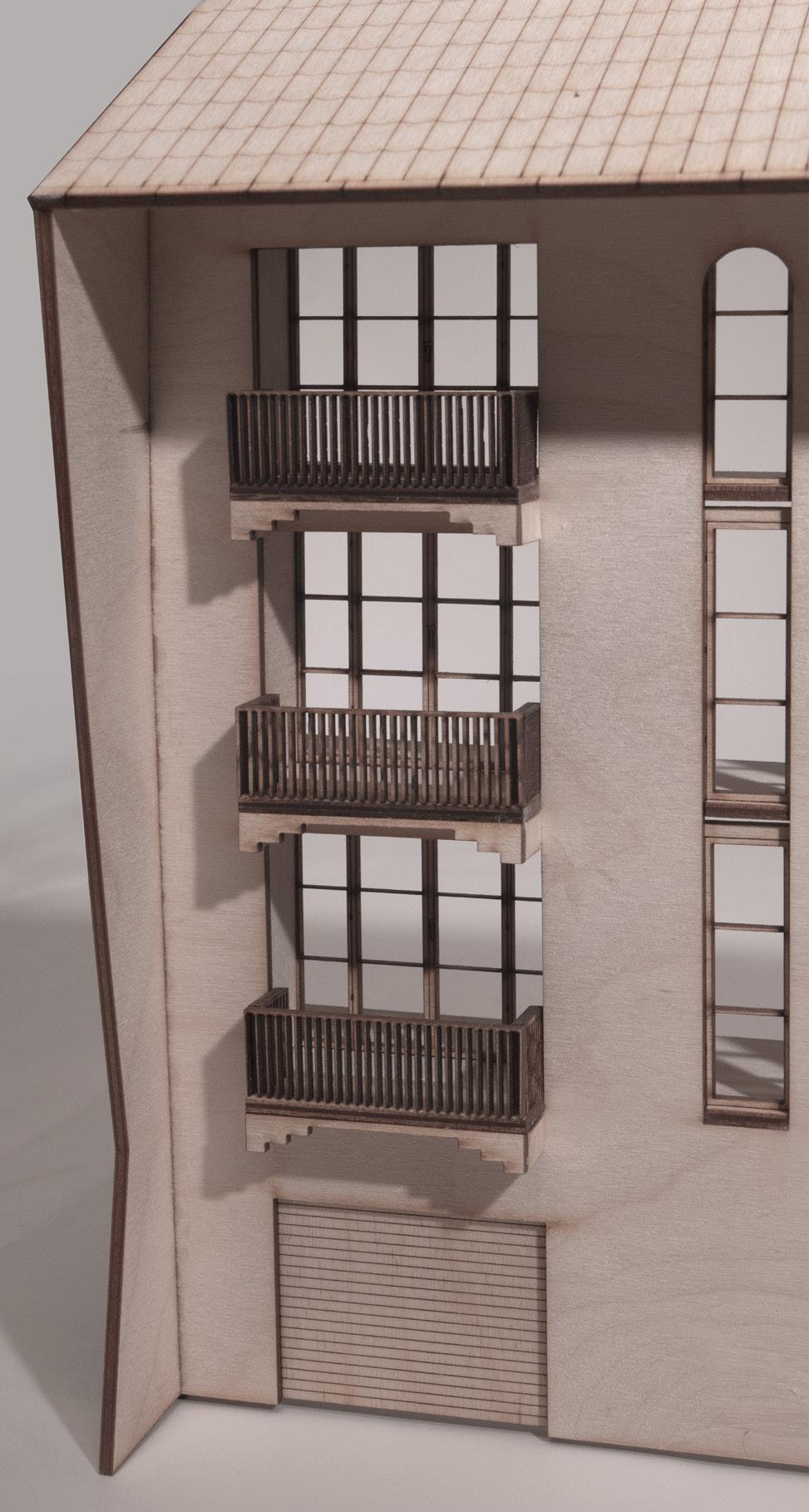
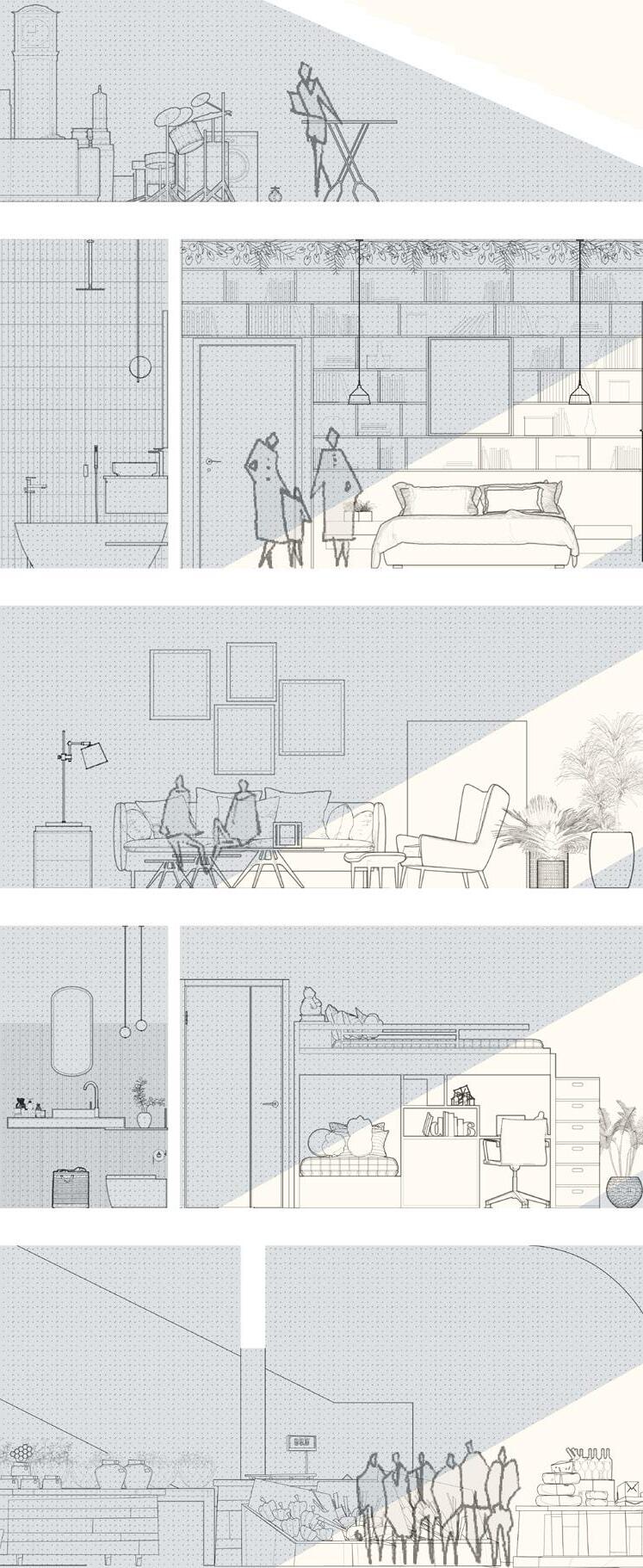
In addition to utilizing the arches to capture the sun’s heat during the winter and dissipate it during the summer, the entire roof area will be outfitted with solar panels. The slanted portion will incorporate Soltech technology, while the flat roof will use conventional panels.
Beneath the solar panels, a garden will be established, sheltered from direct sunlight to allow for optimal growth. The base of the tiles is black nylon, which absorbs heat and transmits it to the air that circulates under the tiles, heating it. Air is channeled to a heat accumulator and used for heating or hot water. So the tiles do not heat water, but rather they heat air. The system generates about 350 kWh of heat per square meter, depending on the climate.
Bio-retention swales, water drainage and water recycling
4
Metal sheet gutter, with water collection for “grey waters.”
DETAIL 2
DETAIL 3
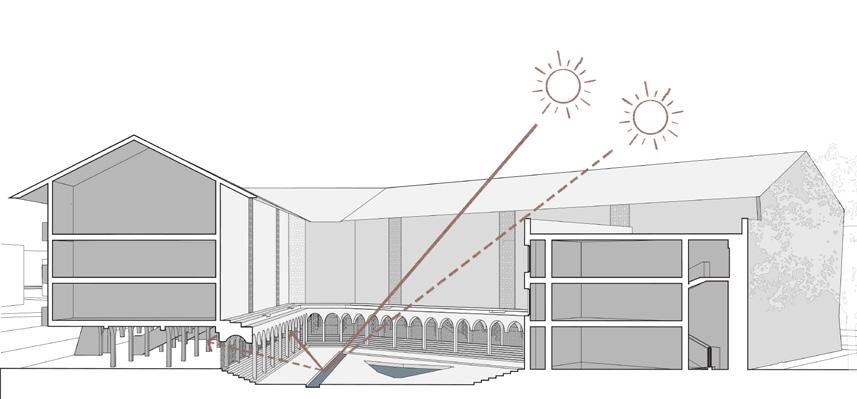
Relative compaction of subgrade to be similar to native soils
10cm diameter cobblestones, flush with curb. Openings for distance 5mm downstream from curb openings. Sandy loam 50cm depth
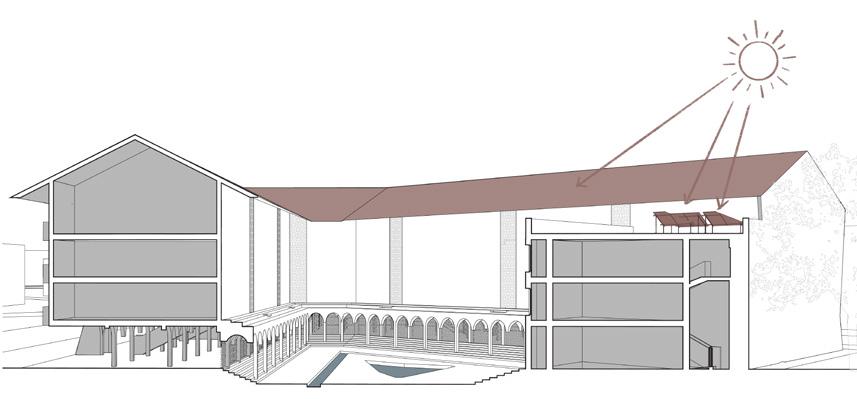
4cm “sunol top sand”
Set bottom of curb such that subdrain is above zone of influence plane.
Underdrain cleanout with rim to fine grade.
2% slope
10cm diameter perforated slopedunderdrain (slope at 0.50%) with perforations down.
2cm diameter washed drain rock wrapped in TC mirafilterweave 400 filter fabric.
2% slope
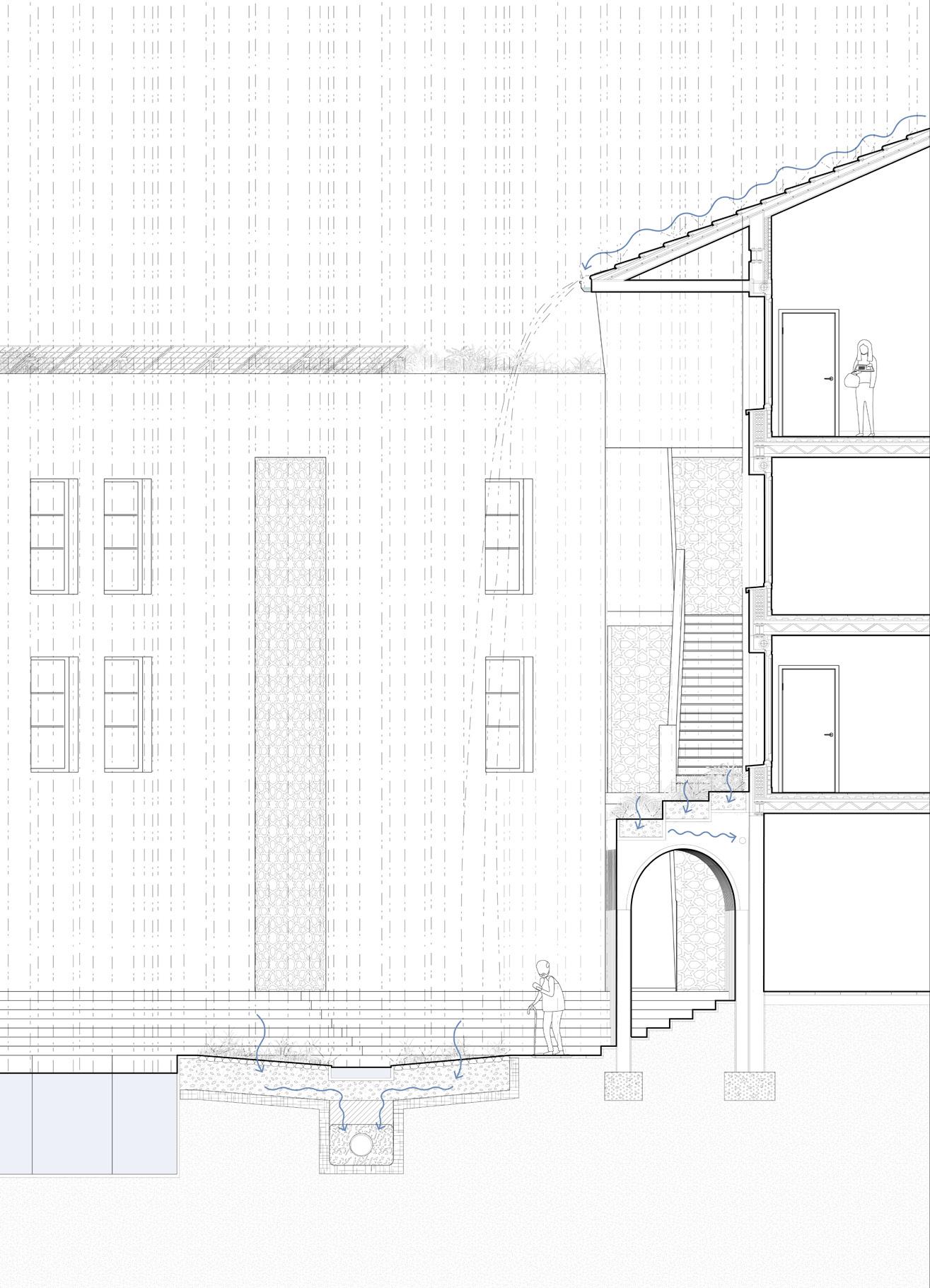
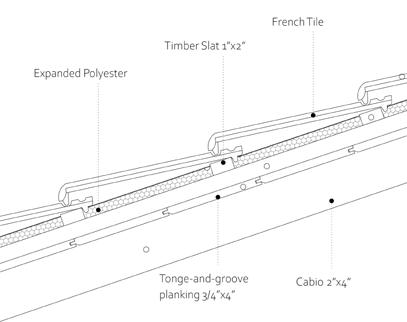
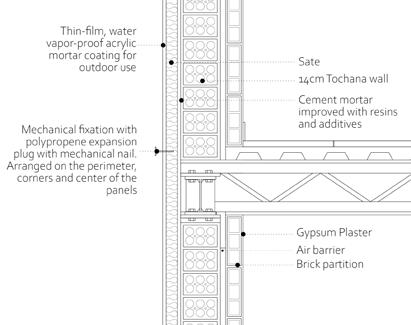
4cm diameter perforated slopedunderdrain (slope at 0.50%) with perforations down.
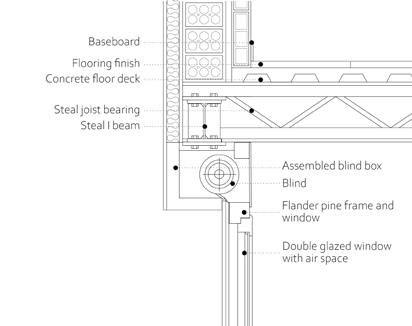
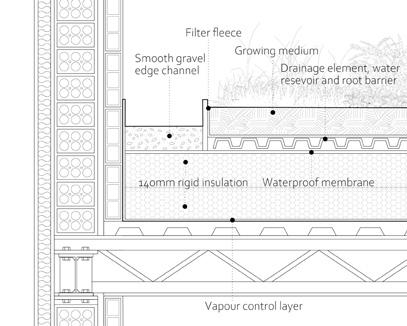
Similar to the Alhambra, this design also incorporates a central courtyard as a primary method of cooling down the space. The courtyard is designed to be open to the sky, and surrounded by shaded areas such as arcades. To further lower the temperature, fountains are strategically placed in the courtyard to create a cooling effect through evaporation. Additionally, the design features porticos to provide shading, and the catchment of water running through them.
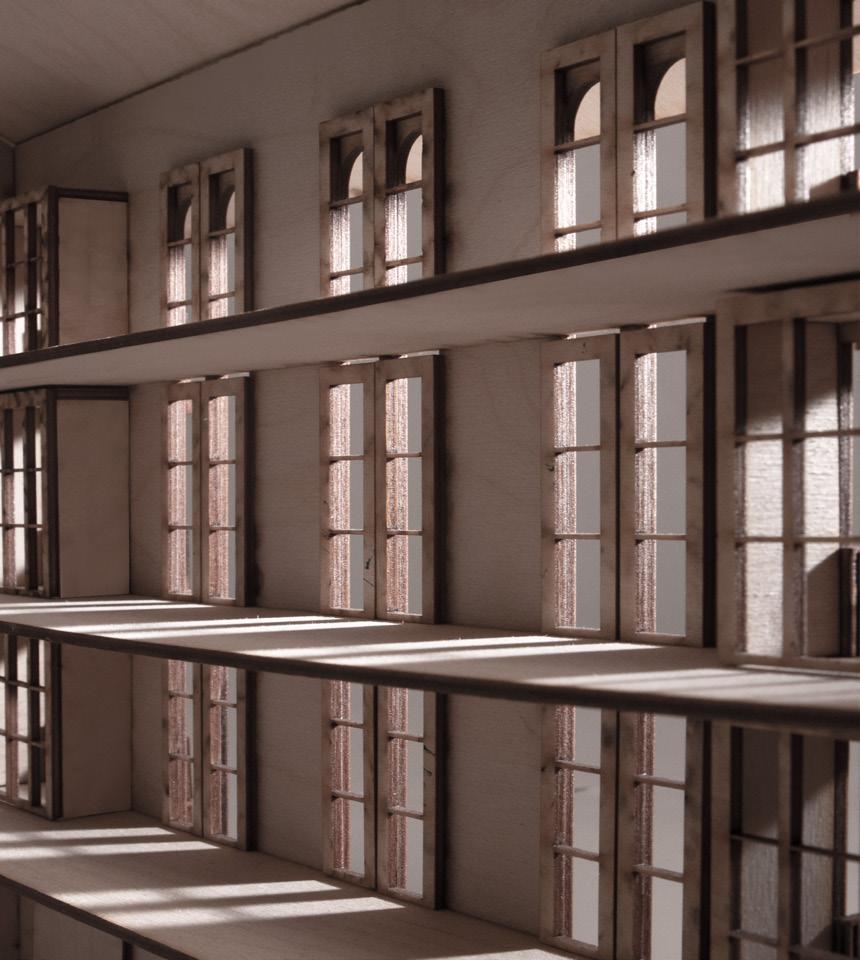


By incorporating vernacular climate adaptation techniques (ventilation, sun blocking, sun harnessing, and evaporative cooling), alongside innovative sustainable engineering practices (solar panels, bioretention swales, and water filtering systems), as well as ensuring proper insulation for walls and windows, we design a culturally fitting, low-emission, efficient, and climate-adaptive apartment block.
This work can be expanded in various ways. By compiling vernacular methods relevant to the specific environment and integrating them with existing climate control and sustainable building databases, the aim is to develop a versatile tool. The objective is to ensure scientific accuracy while also considering aesthetics and cultural relevance.
Analyze site for sun exposure.


Analyze site for wind speeds.
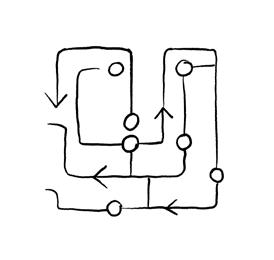
Create an algorithm that determines which design interventions would be most beneficial per building.
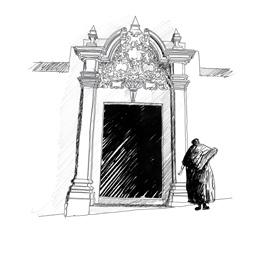
Filter the outcomes through a list of vernacular architecture techniques and provide a set of vernacular and modern design solutions.
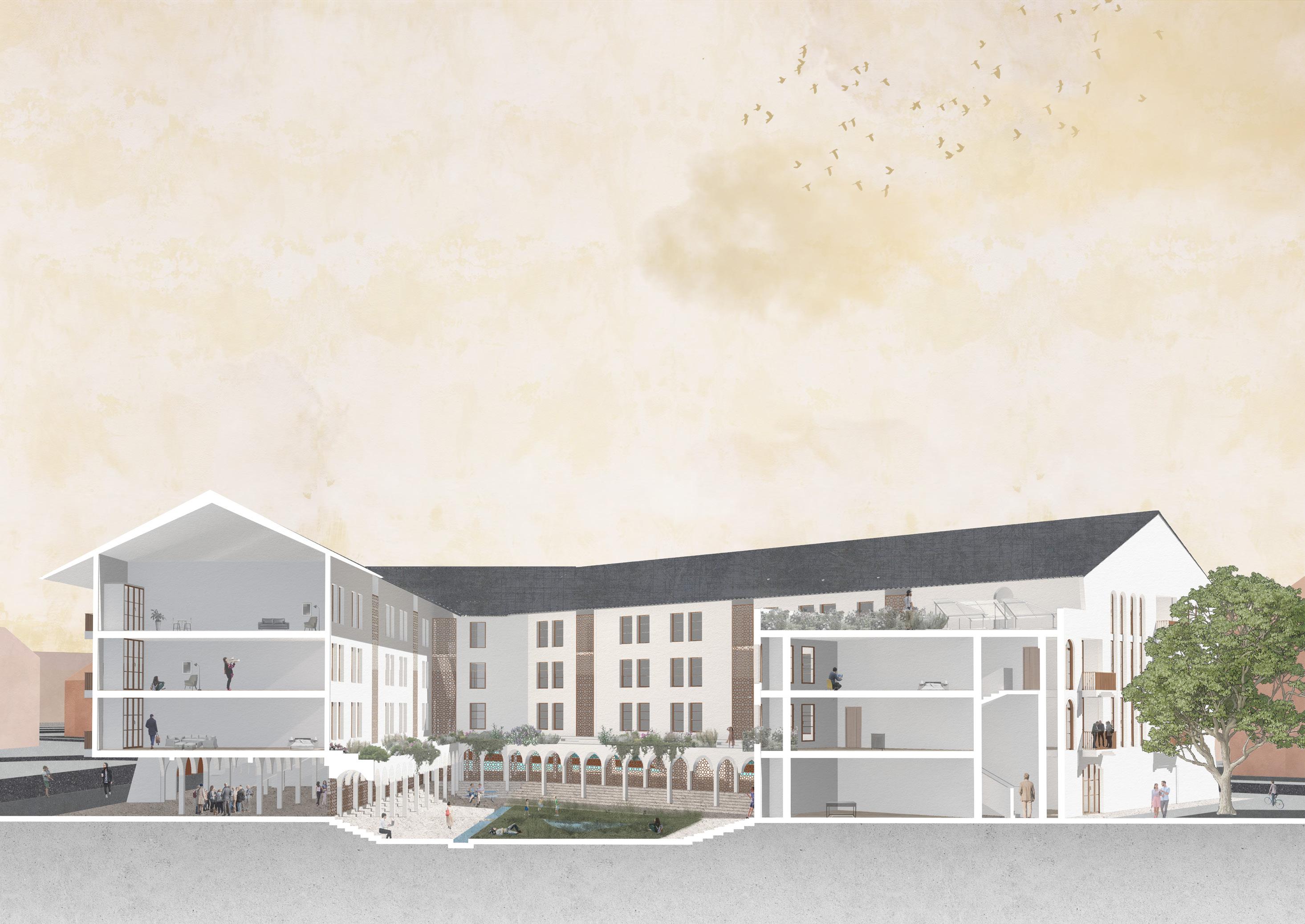
Decision making tool for design
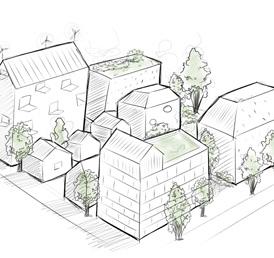

Database of what is most important and effective while still being aesthetic.
STUDENT COMMONS PAVILION
By carving out of a jungle of wooden columns the public will have a sense of enclosure while still allowing light to filter through. Even though the concept word of this project is SURROUND, the intention is not to induce claustrophobia in the public, but rather, to surround them by only providing specific accesses to the rooms. This will enclose the users while creating private and public spaces.
This project is centered around the idea of surrounding and enclosing the movement and view of the public with special care on the materials used and the effect the light plays on these spaces.
Architectural Studio III
Instructor: Tei Carpenter
Completion: Spring 2021
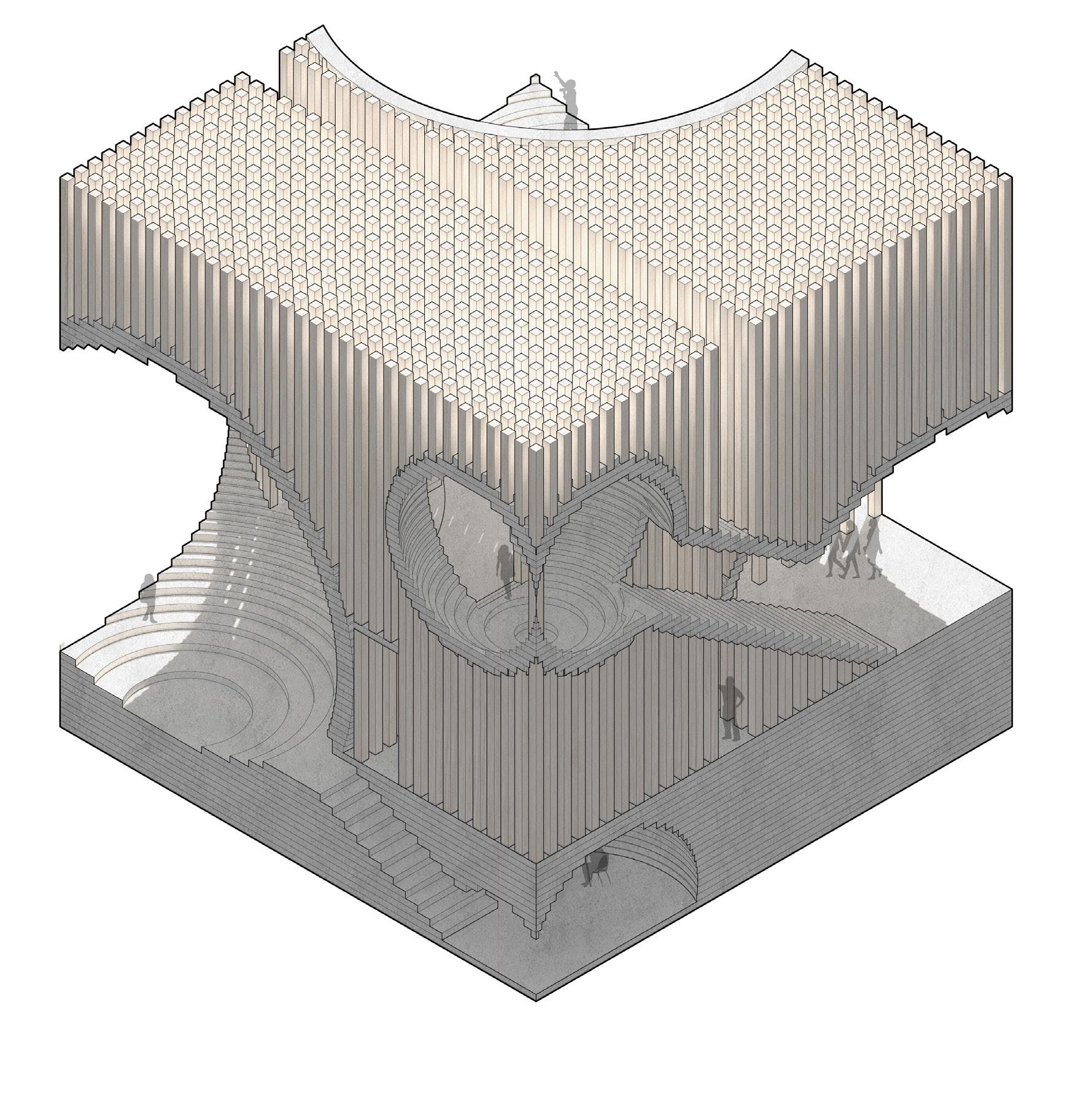



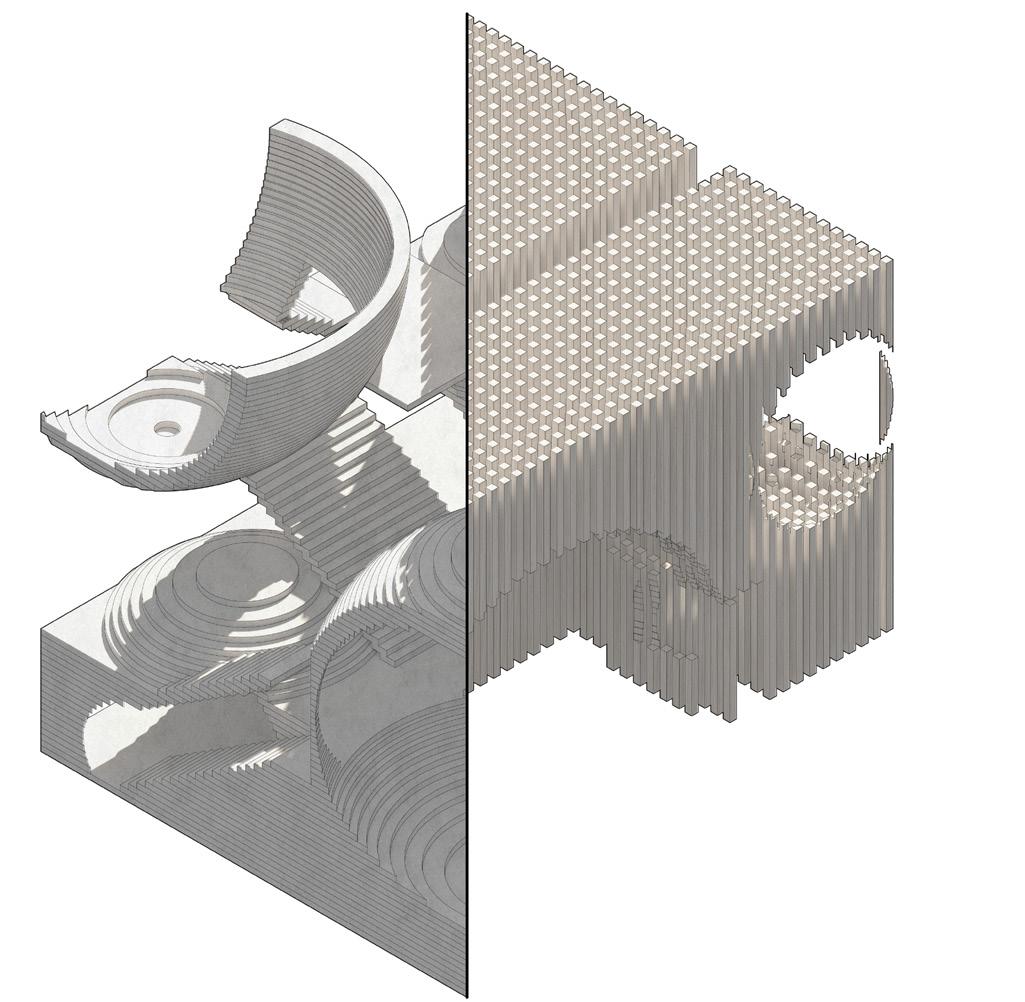
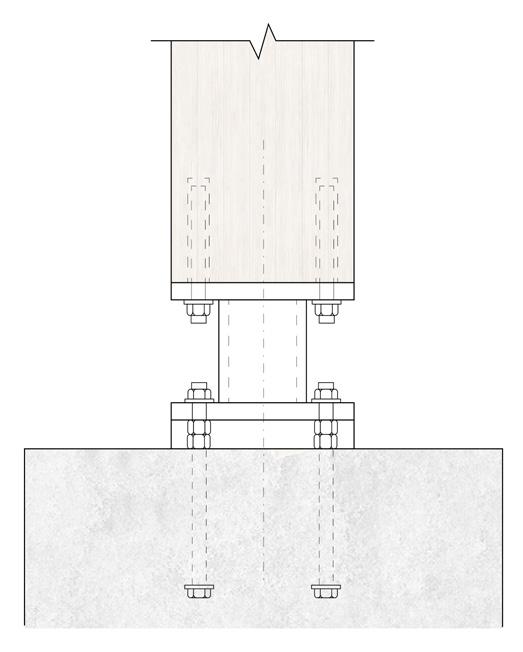

OBSERVATORY PARAMETRIC TOWERS
This parametric tower design is intricately crafted to harmonize with the lush surroundings of the jungle. Inspired by the sinuous forms of snakes, its architecture blends seamlessly into the natural landscape. The parametric nature of the tower allows for a dynamic adaptation to its environment, ensuring optimal integration with the jungle’s flora and fauna.
The facade, composed of an arrayed component, not only resembles the textured skin of a snake but also serves as a functional feature, providing shade and ventilation while maintaining a visual connection to the natural world. This parametric approach not only enhances the aesthetic appeal of the tower but also underscores its commitment to ecological sensitivity and biomimicry.
Modeling and Fabrication in Design
Instructor: Nicholas Hoban
Completion: Spring 2021

1.
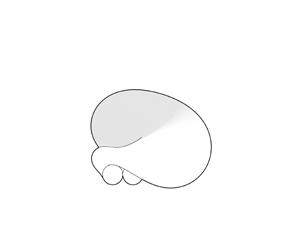
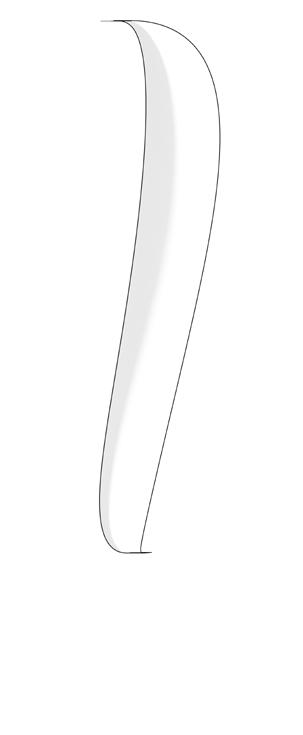
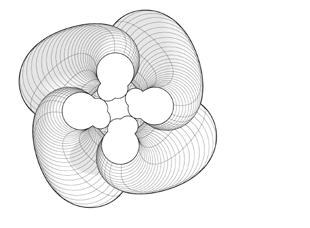
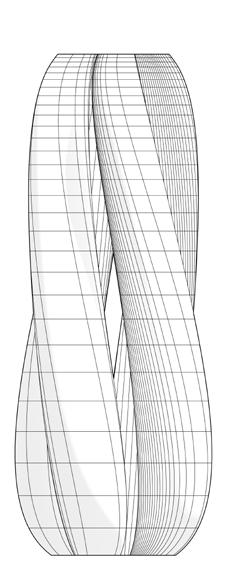



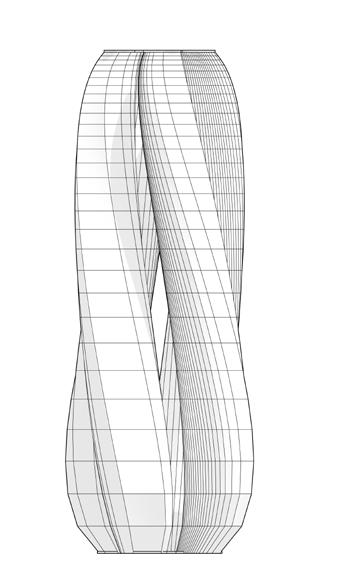

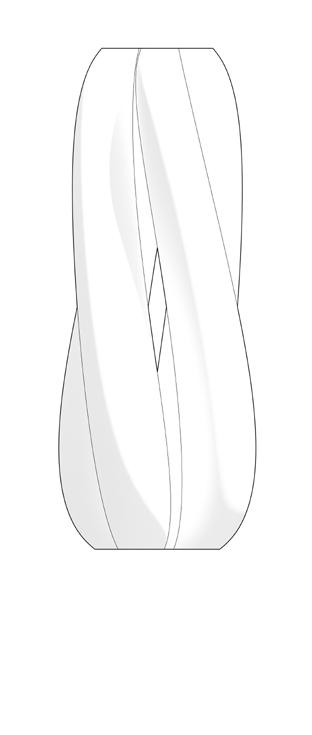
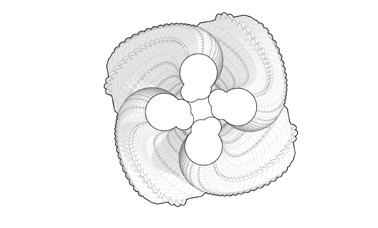

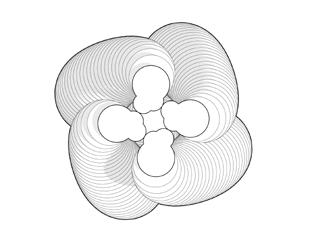

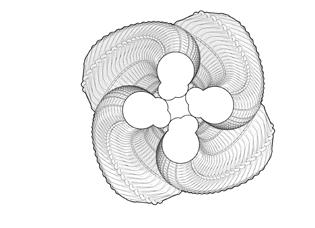
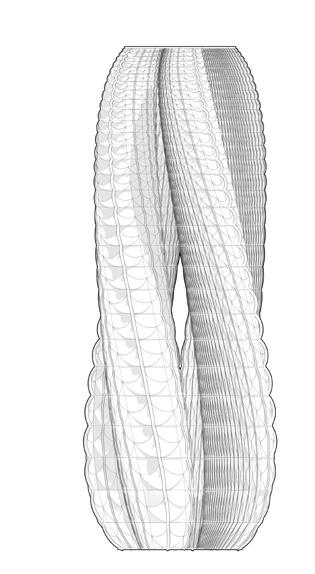
Parametric Methodology
These drawings showcase the hundred meter tall tower which is a result of changing the angle of rotation, the radius of the base circles and the number of towers. For the final design iteration the component is made out of 3 arcs which vary in height and width according to the size of the panel.
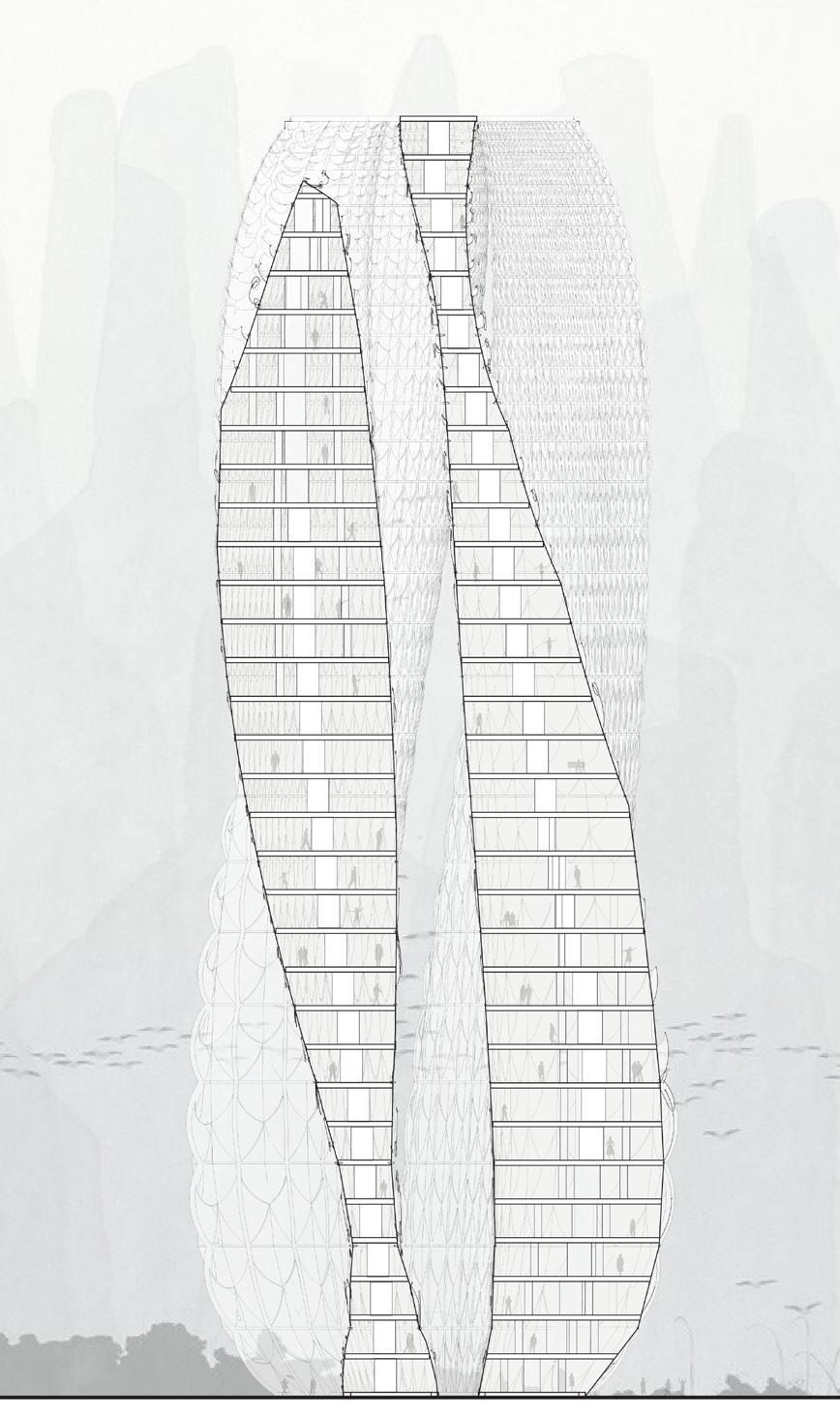
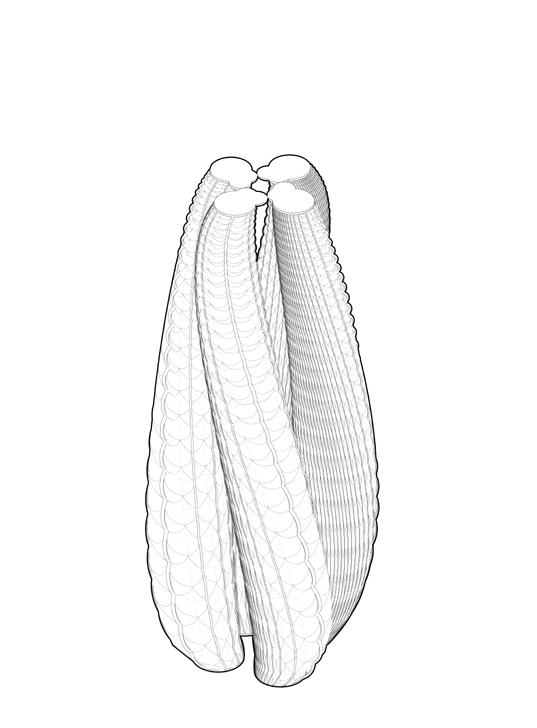
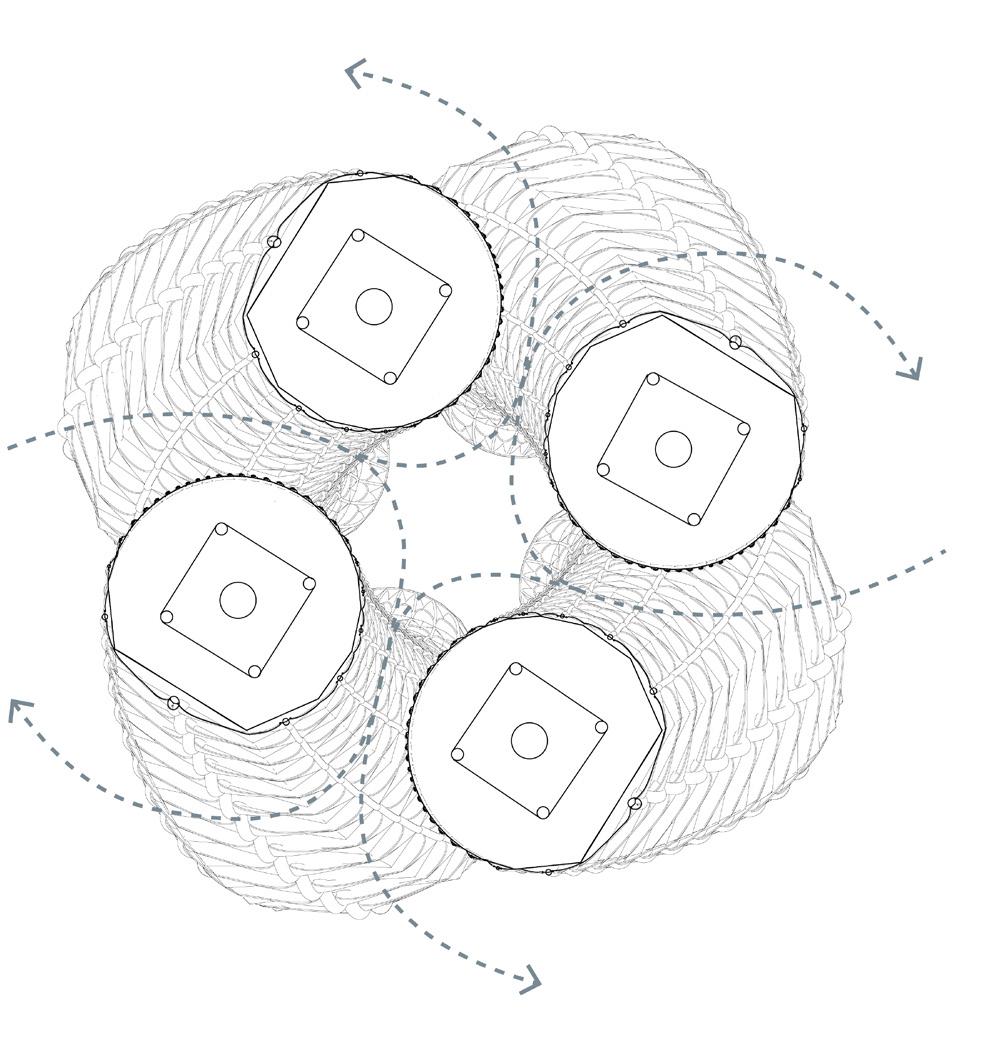

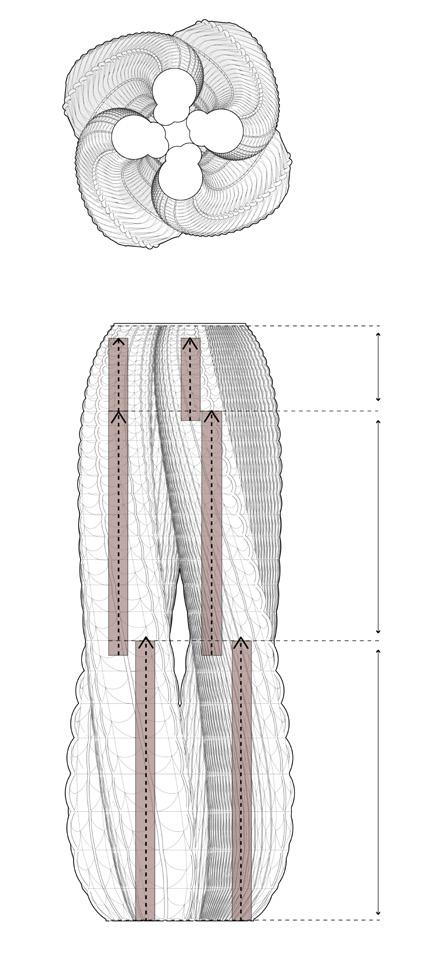



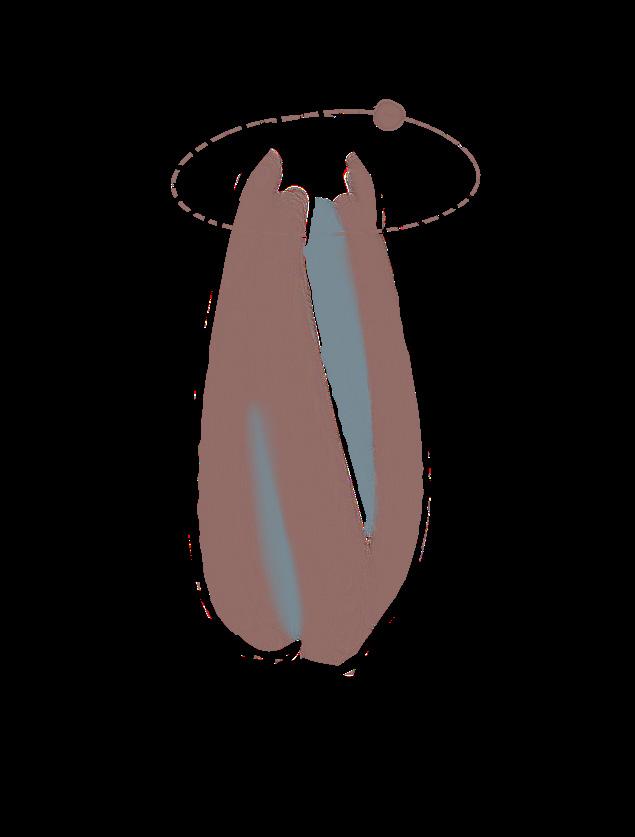

The Parametric Jungle Tower emerges as a blend of nature and innovation, designed to mimic the colors and shapes of its jungle surroundings. Serving as a non-invasive laboratory, it offers scientists a vantage point to study biodiversity, particularly the myriad species of birds, without disrupting their habitat.
From within its walls, researchers observe the vibrant ecosystem, unraveling its mysteries while remaining invisible to the inhabitants outside. This harmonious integration of architecture and environment inspires a deeper appreciation for the delicate balance of nature and human endeavor.
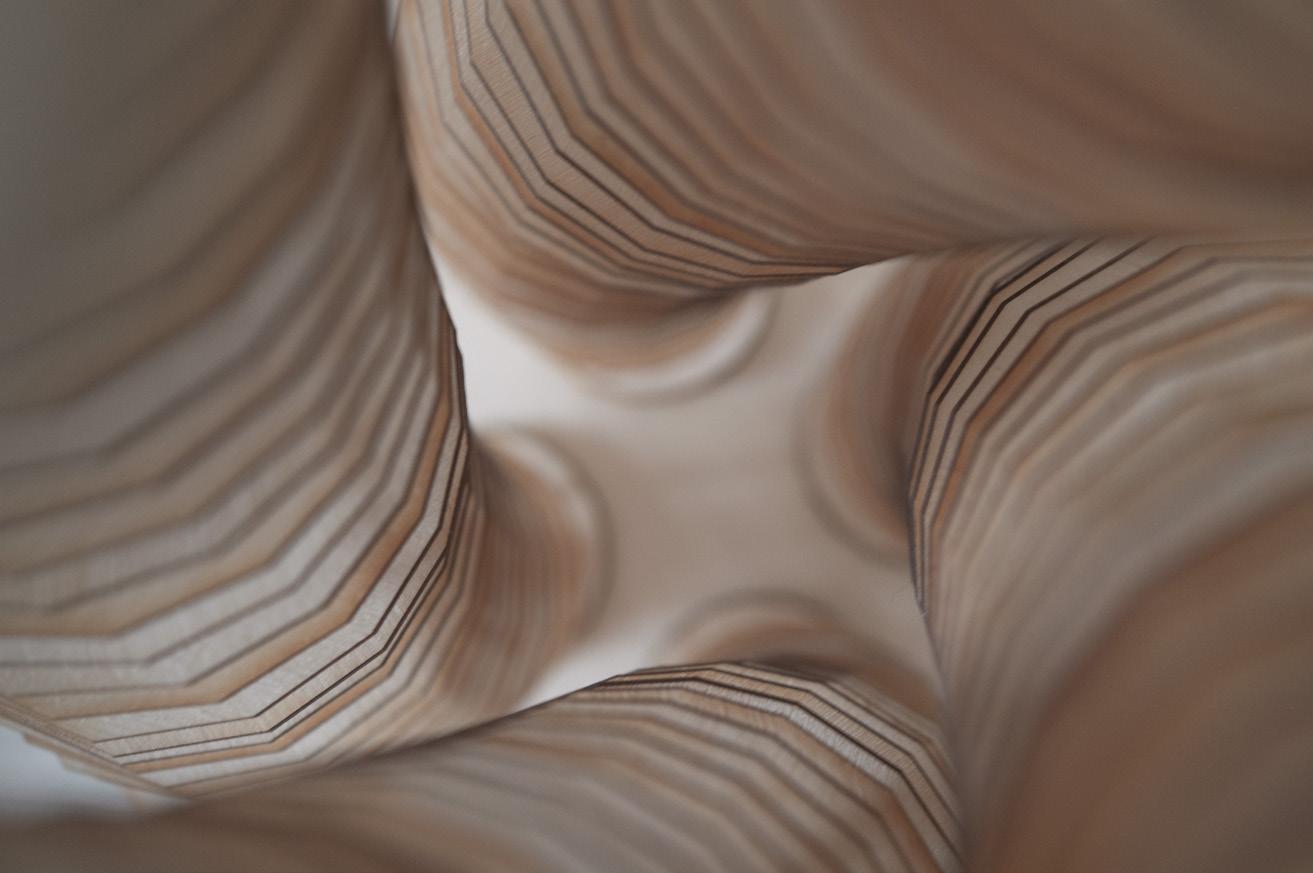
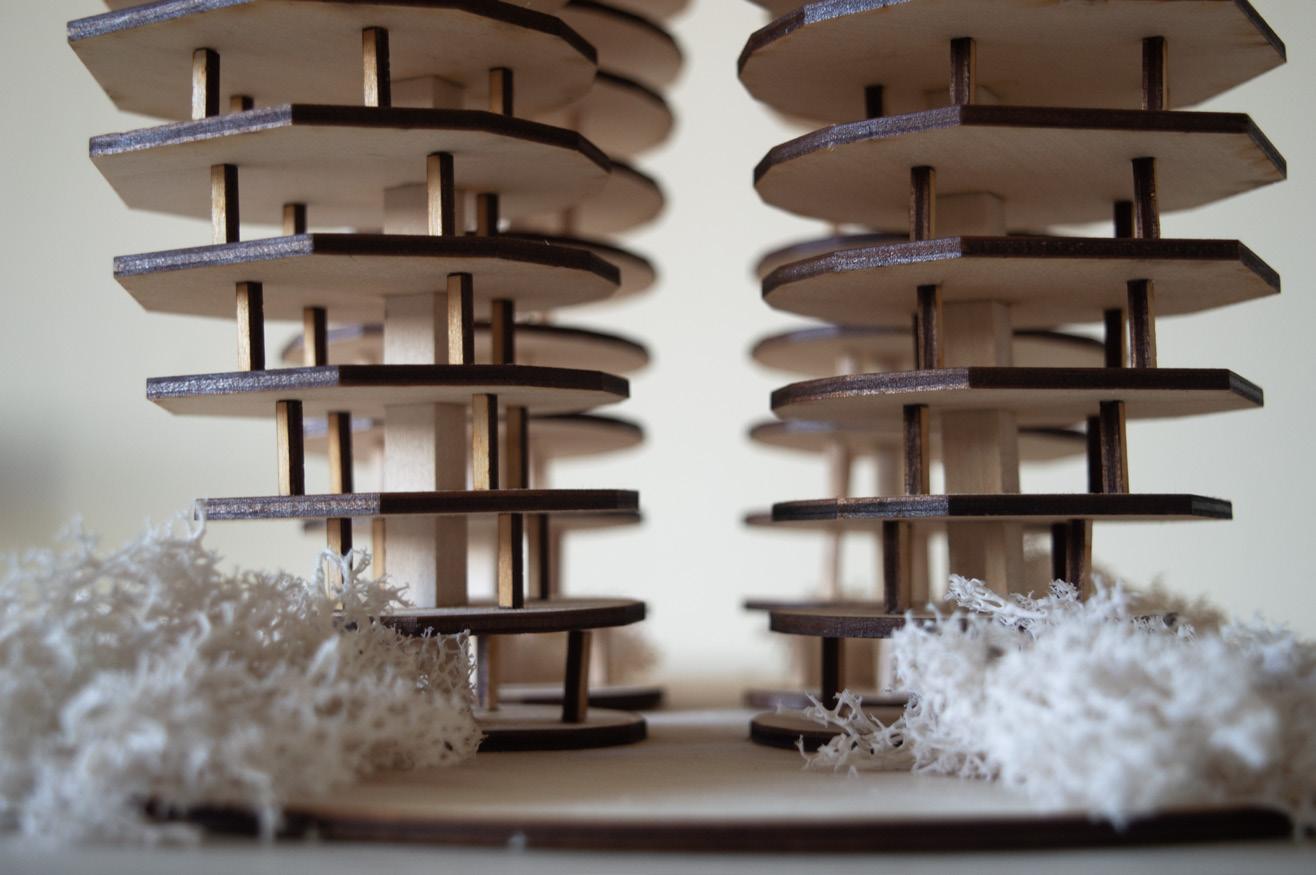

Single Panel Construction
The materials chosen for this tower are the following::
a) Stainless steel
b) Double glazed tinted glass
c) Fine fiberglass mesh (high durability for outdoors and extremely strong and light)
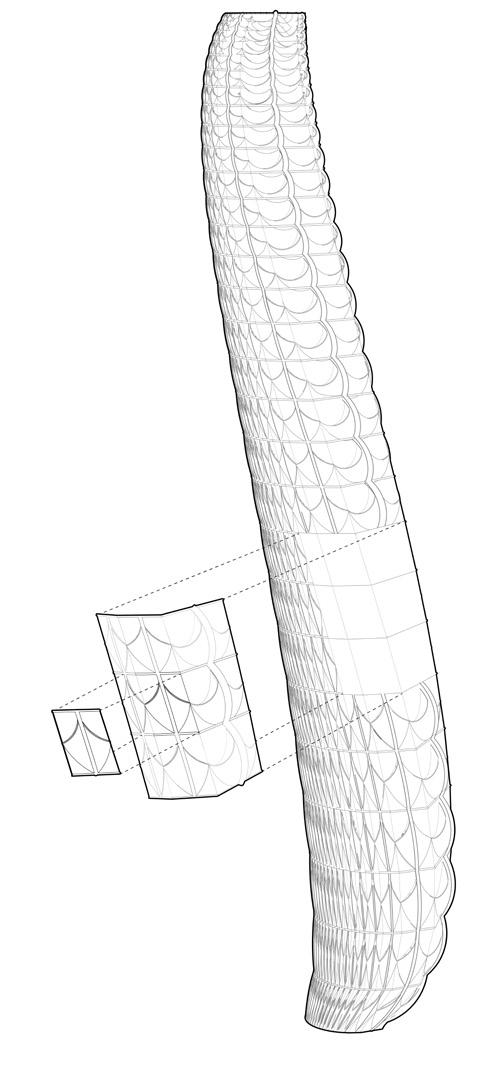

Front Panel Construction:

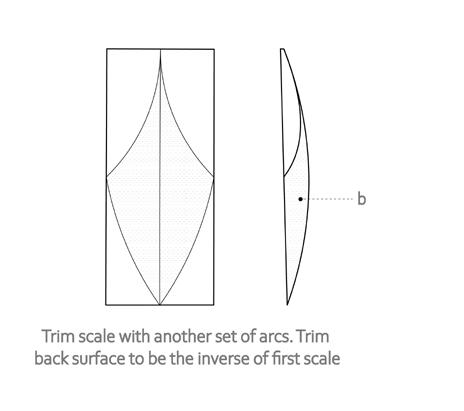
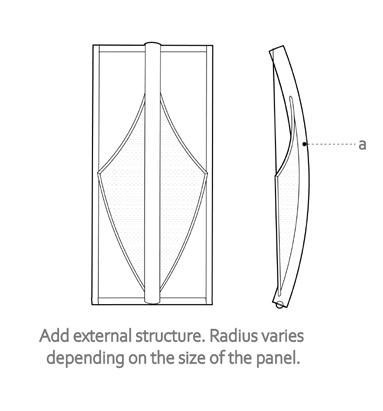
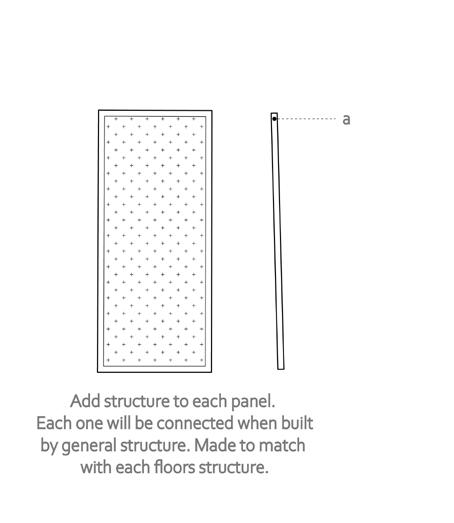
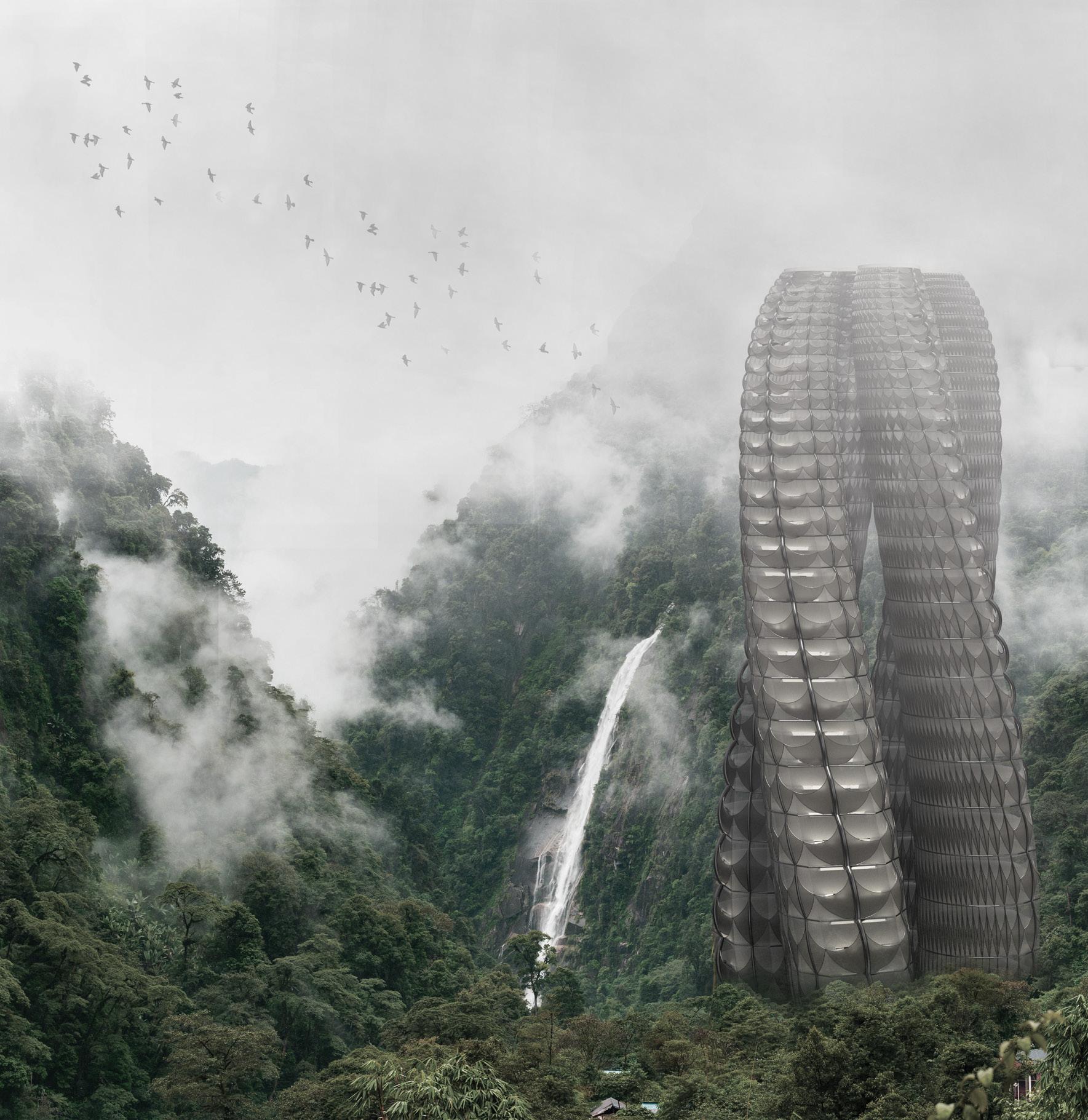
.04
KINETIC PAVILION
At the heart of Toronto’s park stands a kinetic pavilion, showcasing two distinct motions: rotation and bending. They not only serve as aesthetic features but also fundamentally alter the interplay of light and space within the structure. Inspired by the diverse shapes of leaves, the pavilion’s design intricately varies their heights and lengths, creating a cohesive yet dynamic facade. When closed, the pavilion exudes a sense of intimacy with minimal openings, while upon opening, it seamlessly blurs the boundaries between indoor and outdoor spaces.
Crafted from materials chosen for their structural lightness, the pavilion appears almost weightless, allowing light to filter through and cast enchanting patterns within. This interplay of light and motion transforms the pavilion into a dynamic space, inviting visitors to engage with the beauty of nature and architectural innovation in a truly immersive manner.
Technology Studio III; Individual project
Instructor: Nicholas Hoban
Date of completion: Fall 2021
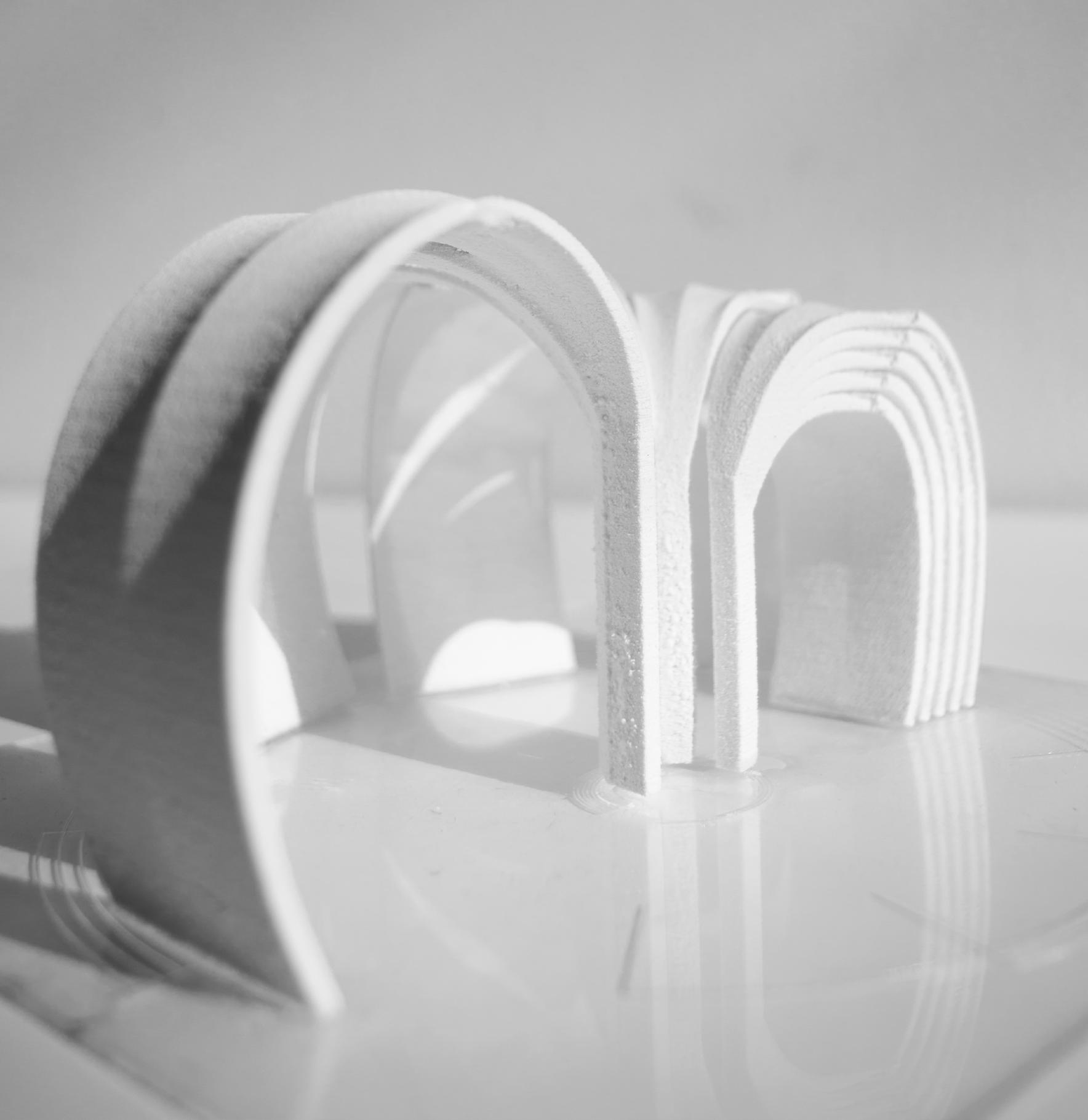
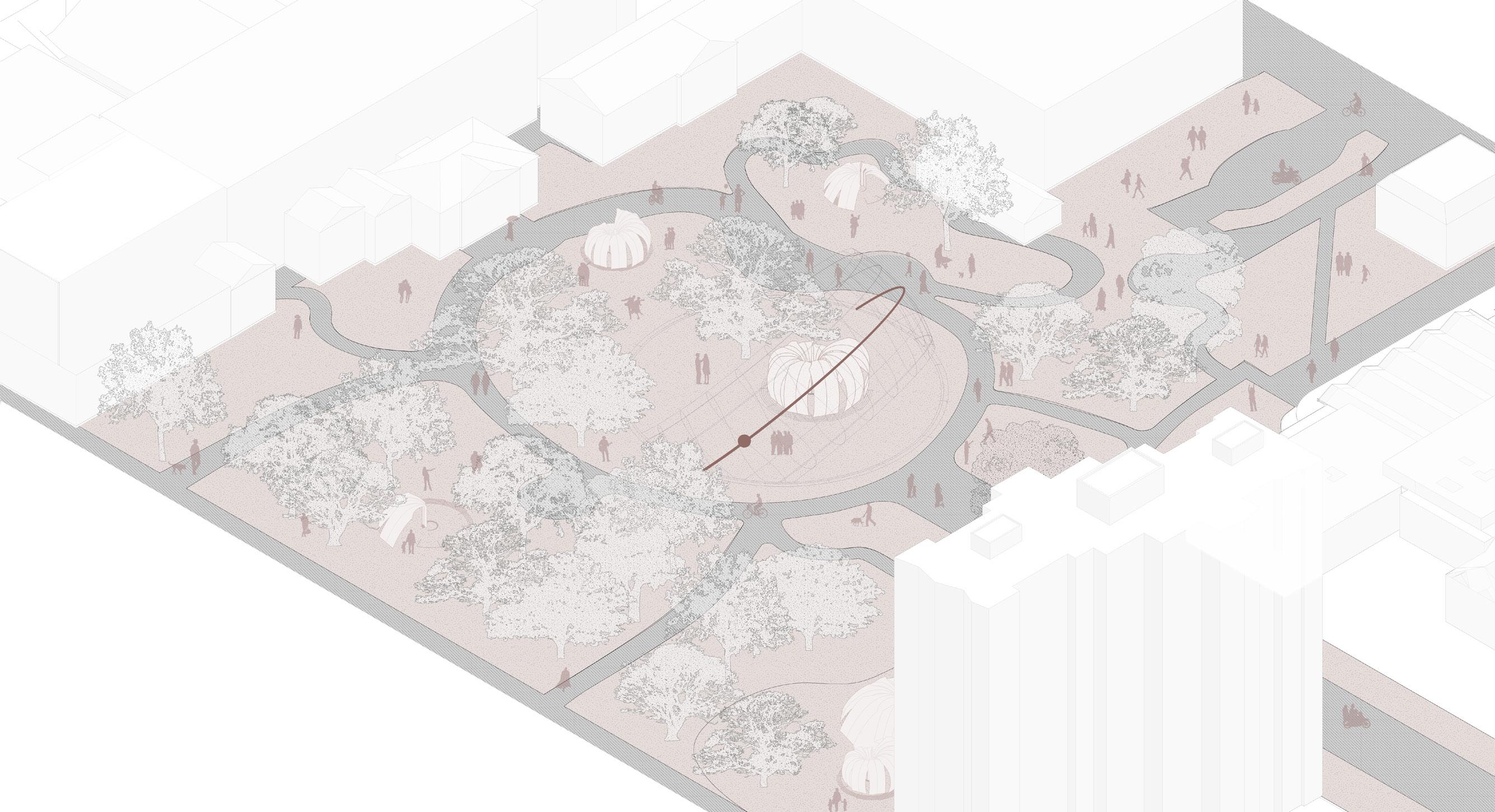

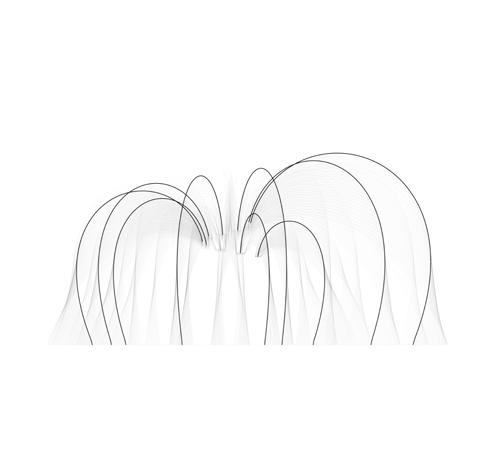


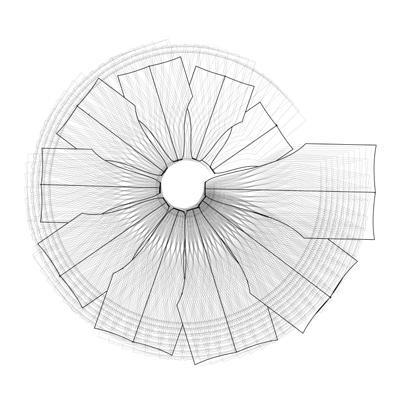

The Grange Park site in Toronto was chosen for its proximity to OCAD University and the Art Gallery of Ontario. The Anemona Pavilion is designed as a summer-only outdoor escape from the city, with six varied pavilions offer ing recreational spaces that users can interact with. The pavilion’s main features include rotating leaves around a central point and buckling forms that enhance light and create dynamic 3D spaces.
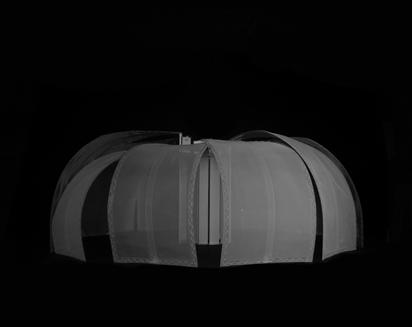
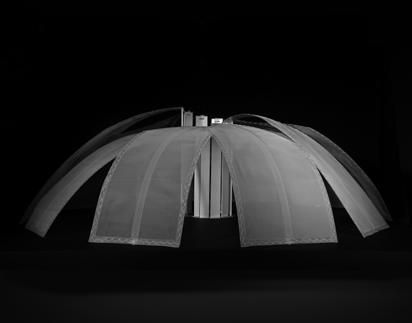
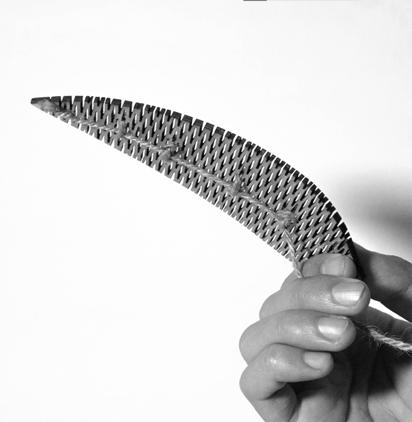

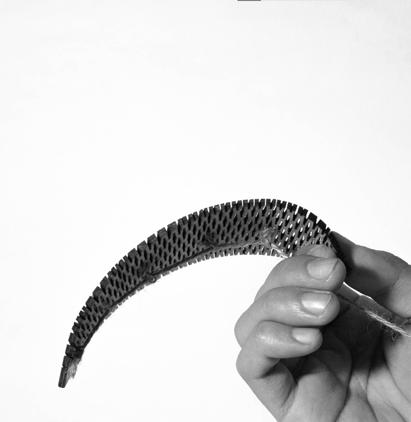
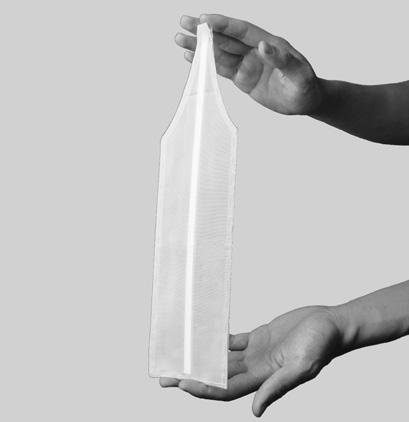

Initially, wood bending was tested for the pavilion using kerf-cut and steam-bent techniques to seamlessly connect the leaf and columns, with six patterns experimented. However, due to wood’s brittleness and unpredictable steam bending, it was abandoned despite its interesting shadows, as it proved too heavy for movement along the railing system. Different leaf shapes were explored to find the most stable structure with desirable shadow and shape outcomes.
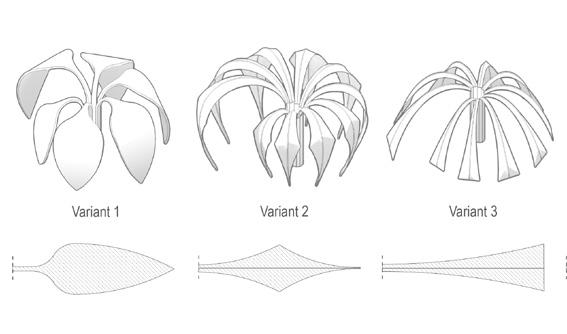
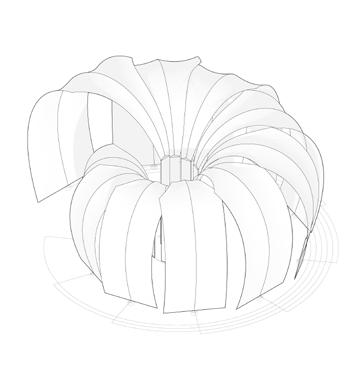
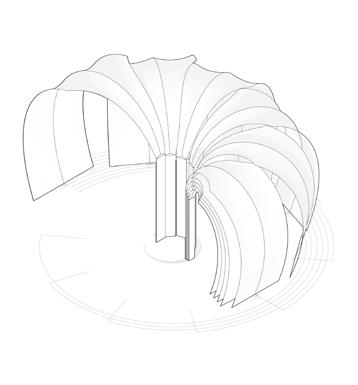
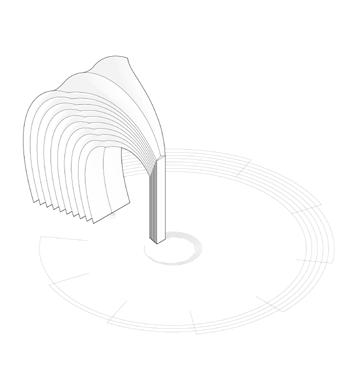
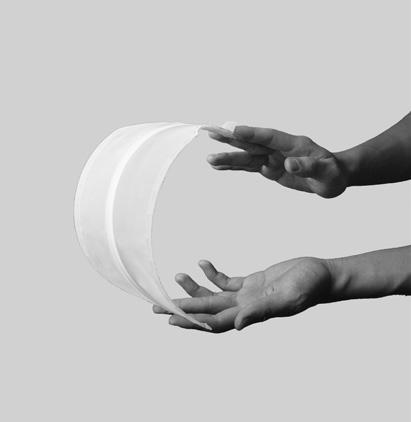
For the final pavilion design, a lighter material was selected to create a semi-transparent screen, allowing light to filter through and establishing a sense of structural lightness. The leaves were designed in varying heights and lengths to create visual interest and maximize light penetration. Whether opened or closed, the pavilion offers different experiences, serving as an intersection between the interior and exterior environments.
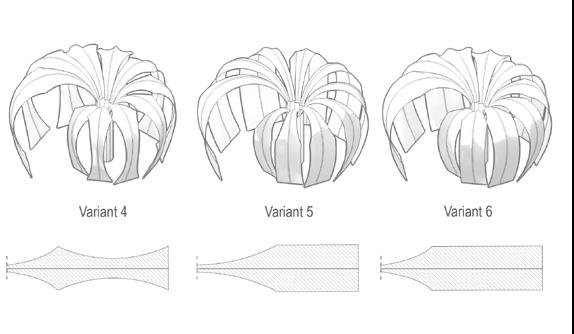
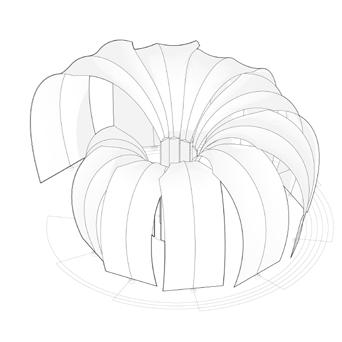


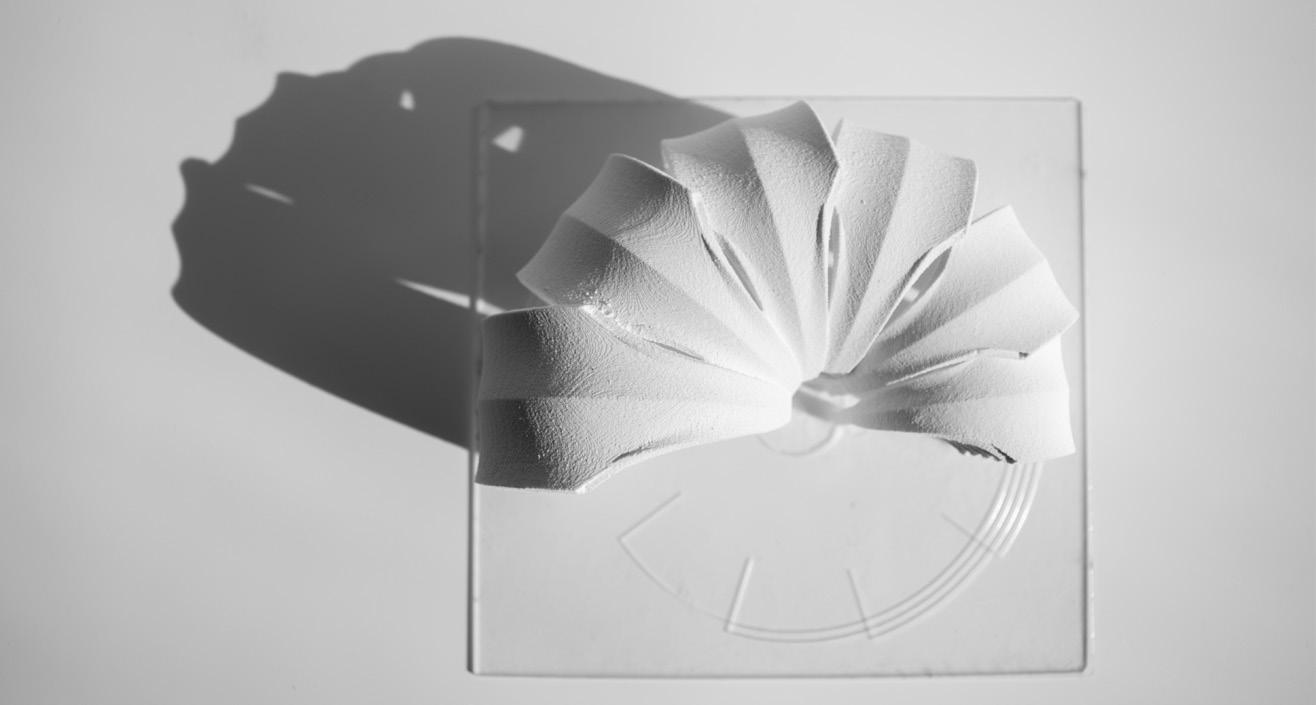
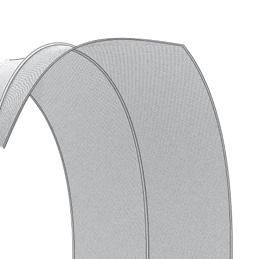
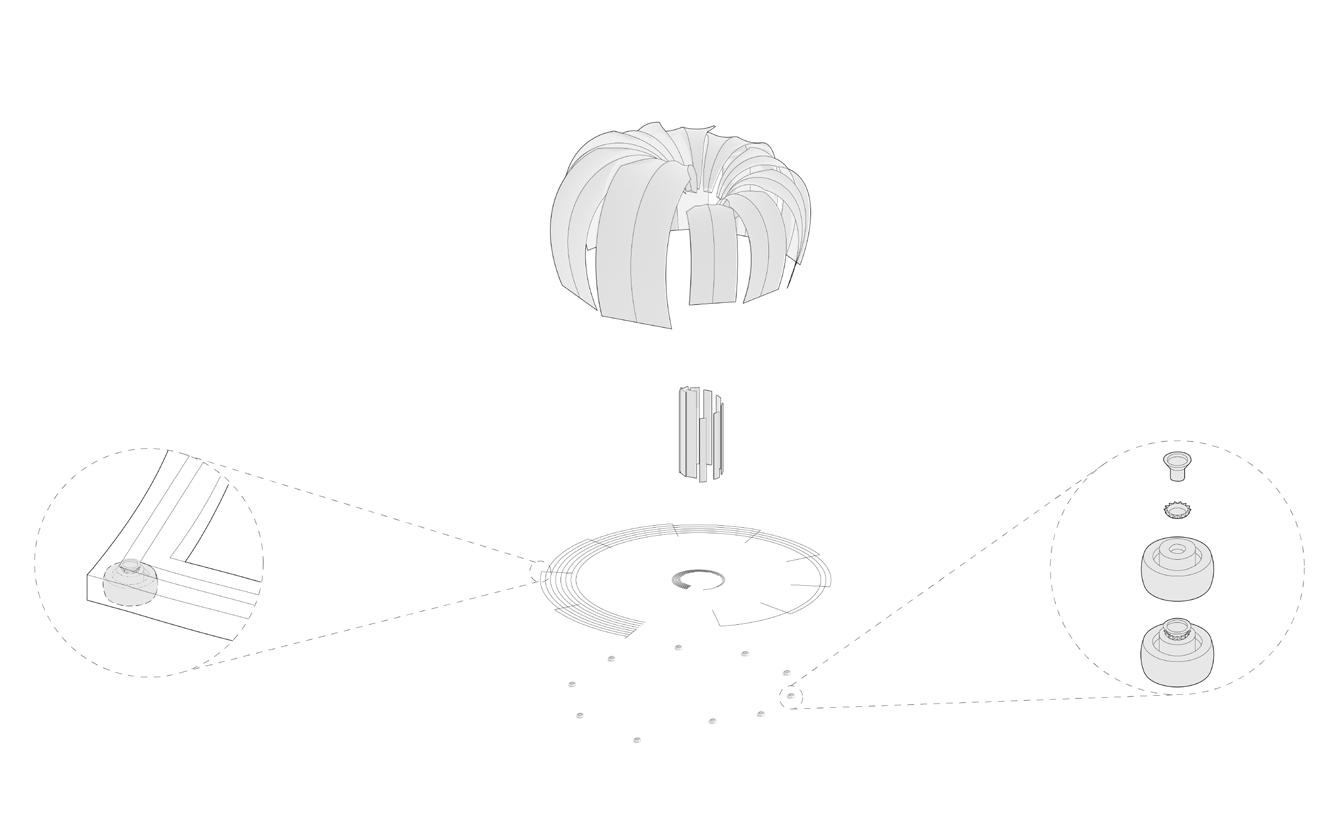
Rail System
- Embedded on the ground for visual and safety matter
Connection Columns-Leaf
- Customized steel hinge as a connection between the steel casing of the leaf and the column
Roller Block
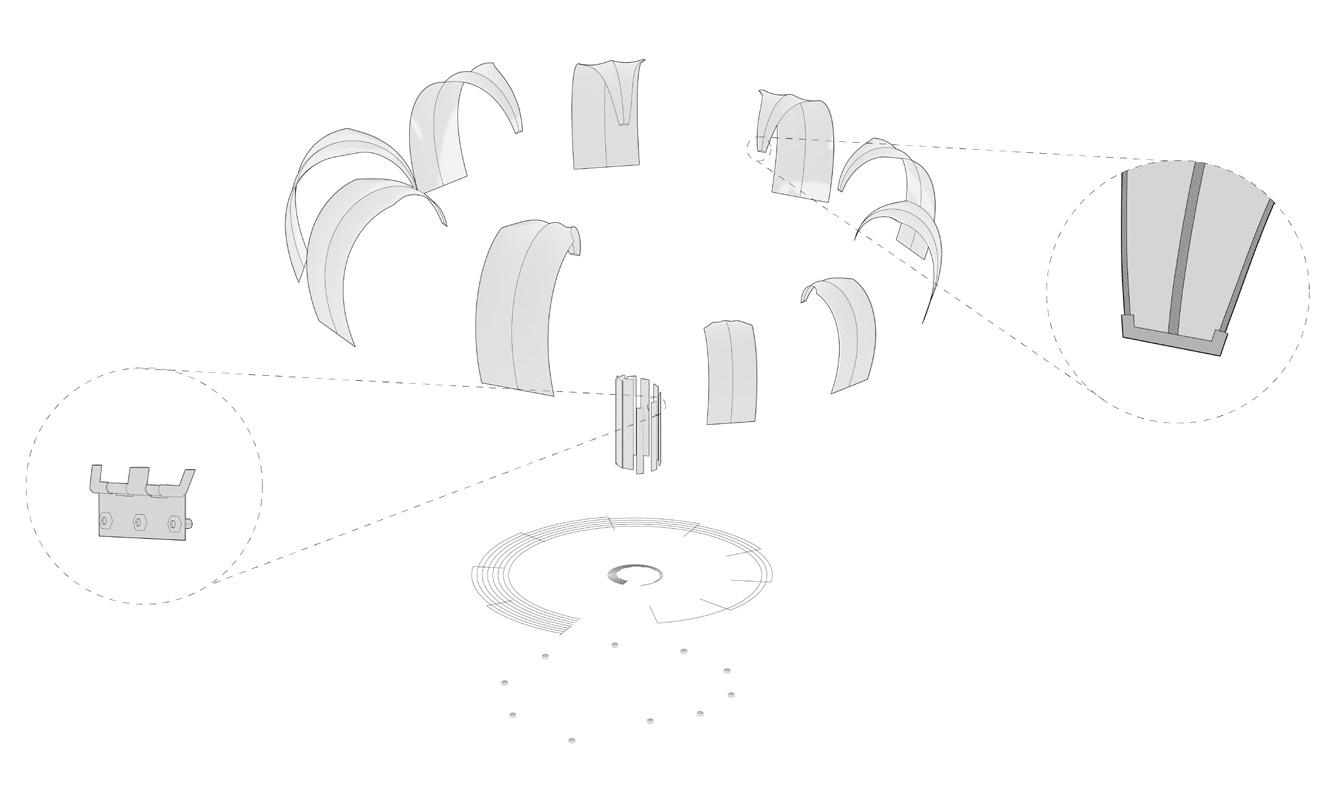

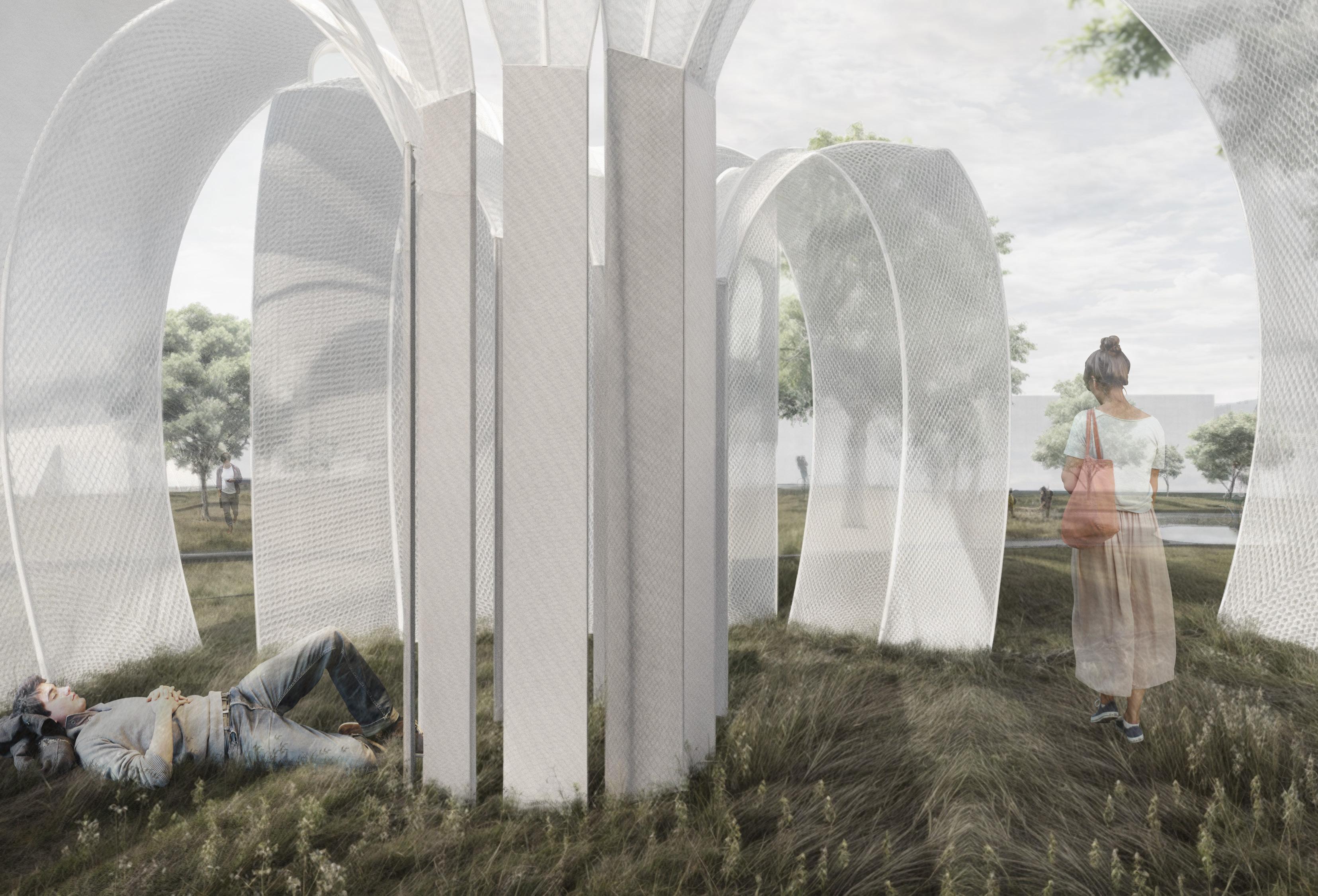
CAMBRIDGE BAY COMMUNITY CENTER
The scope of our project was to design a facade for KPMB’s building. This building, a new Community Centre in Cambridge Bay, Nunavut, will be used for recreation and education.
Cambridge Bay is on an island with extreme climate. Primary concerns: cold, wind, frost, humidity and transport.
The two potential designs were tested based on their energy Input, ability to be constructed modulary, aerodynamic figure and calculated data. The final design generates 20.82 kWh/m2 of power, this is a 21.5% decrease in the buildings emissions. Furthermore the design is aerodynamic and modularly constructable.
Design + Engineering I; Group project
Instructor: Jay Pooley
Client: KPMB architects
Date of completion: Spring 2020
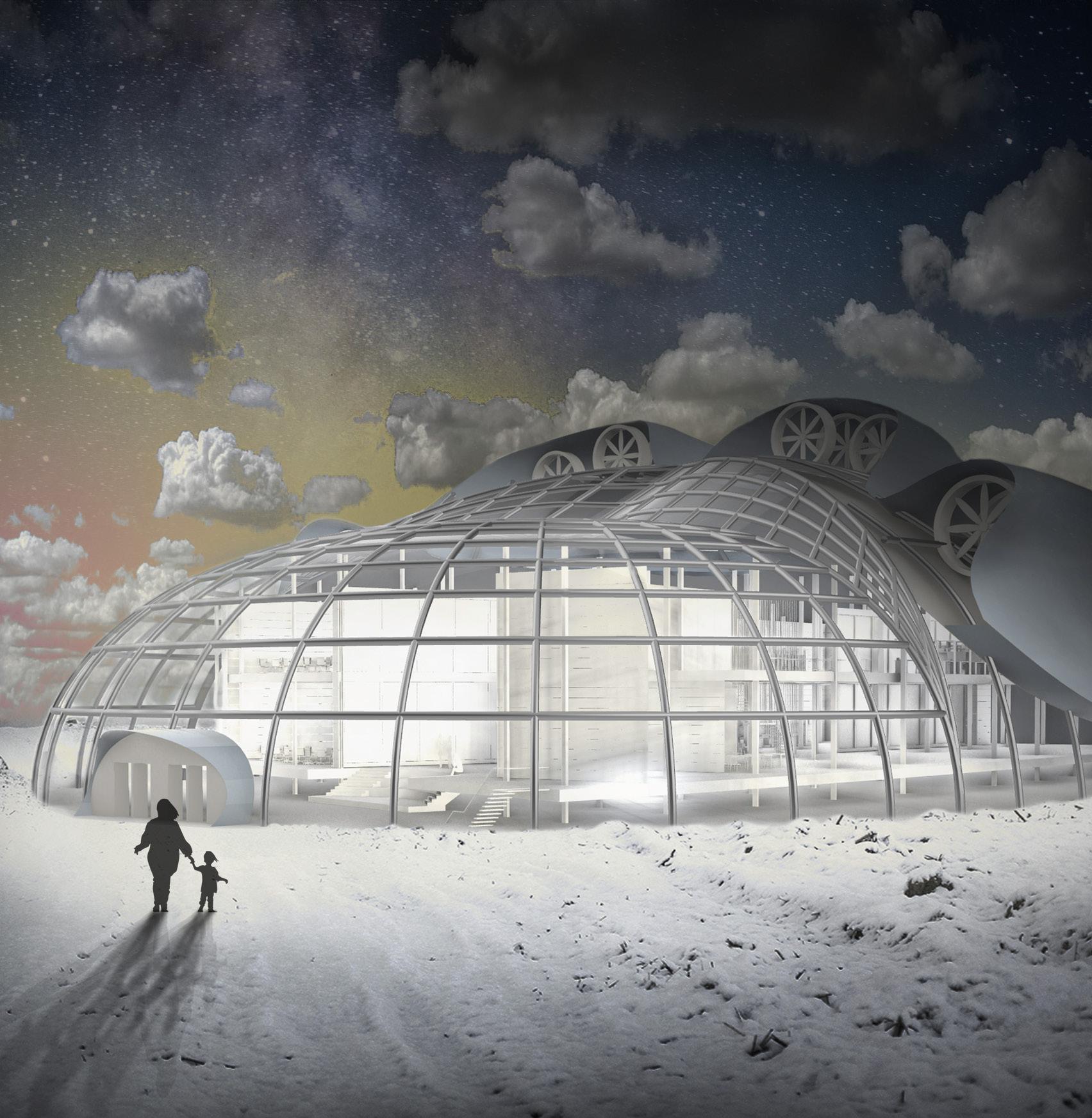
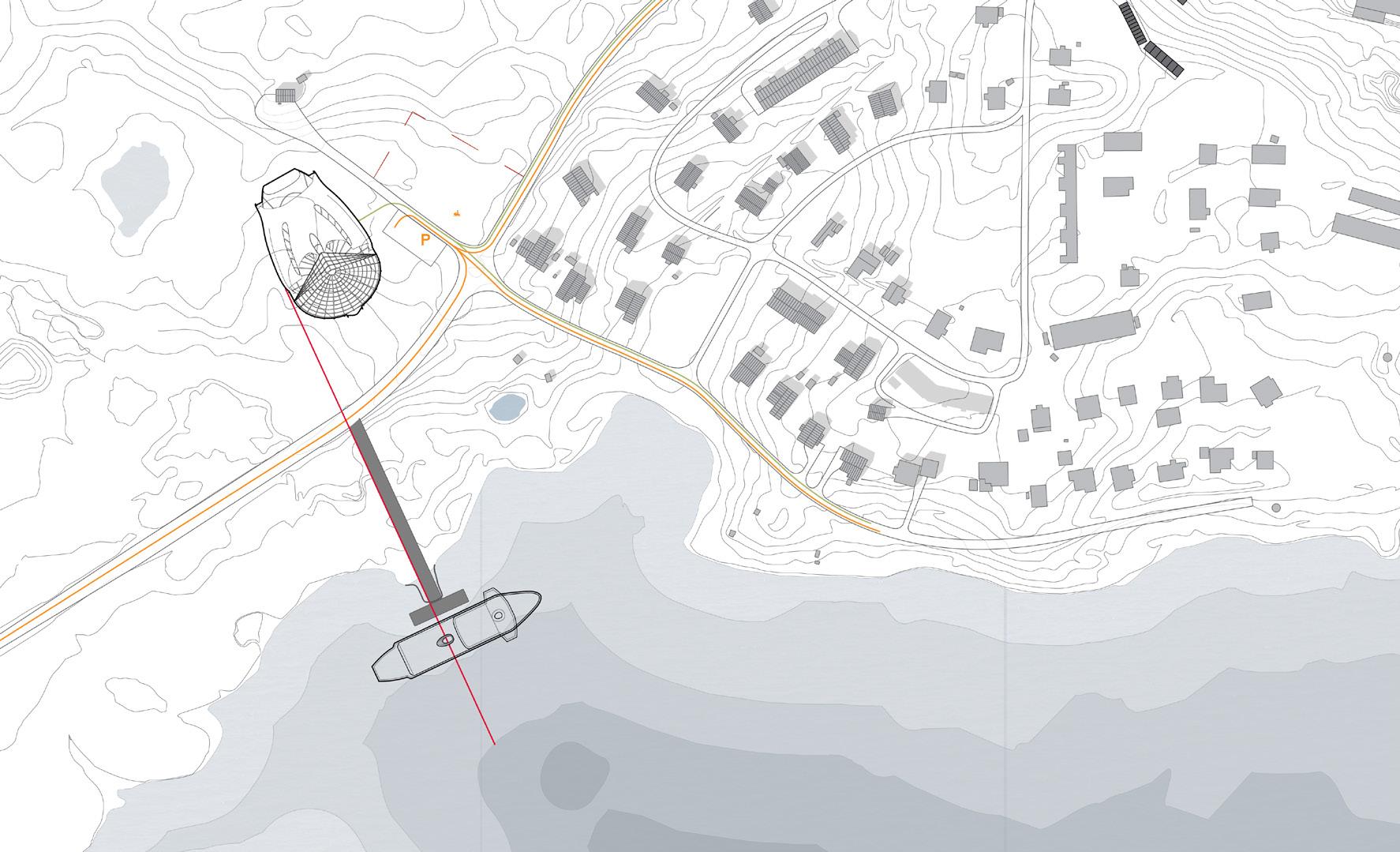
The majority of residents are Indigenous, composed of the Inuit, First Nations, and Métis peoples. Due to the Northern location, the local population has supplies delivered in the summer. Gas is the primary source of fuel. Not only is the southern façade mainly glazing to take advantage of the sun radiation, but it is meant to serve as a vantage to point for Inuvik Sunrise Festival. A very important celebration that marks the end of winter and the return of the sun.

The facade of the building envelops more than the internal building’s surface area to create a greenhouse within the community center. The Arctic region has difficulties shipping in food and supplies, so the greenhouse allows the community to grow their own food. It also helps to improve the mental state of the inhabitants, who lack sunlight for many months of the year. The greenhouse also serves as a place for people to gather, and it creates a sense of community and connection.
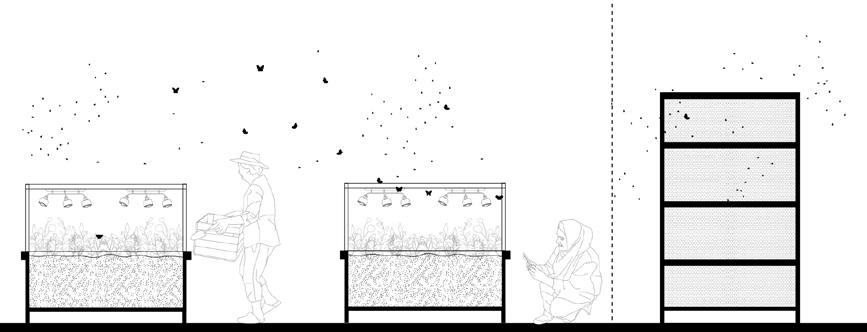
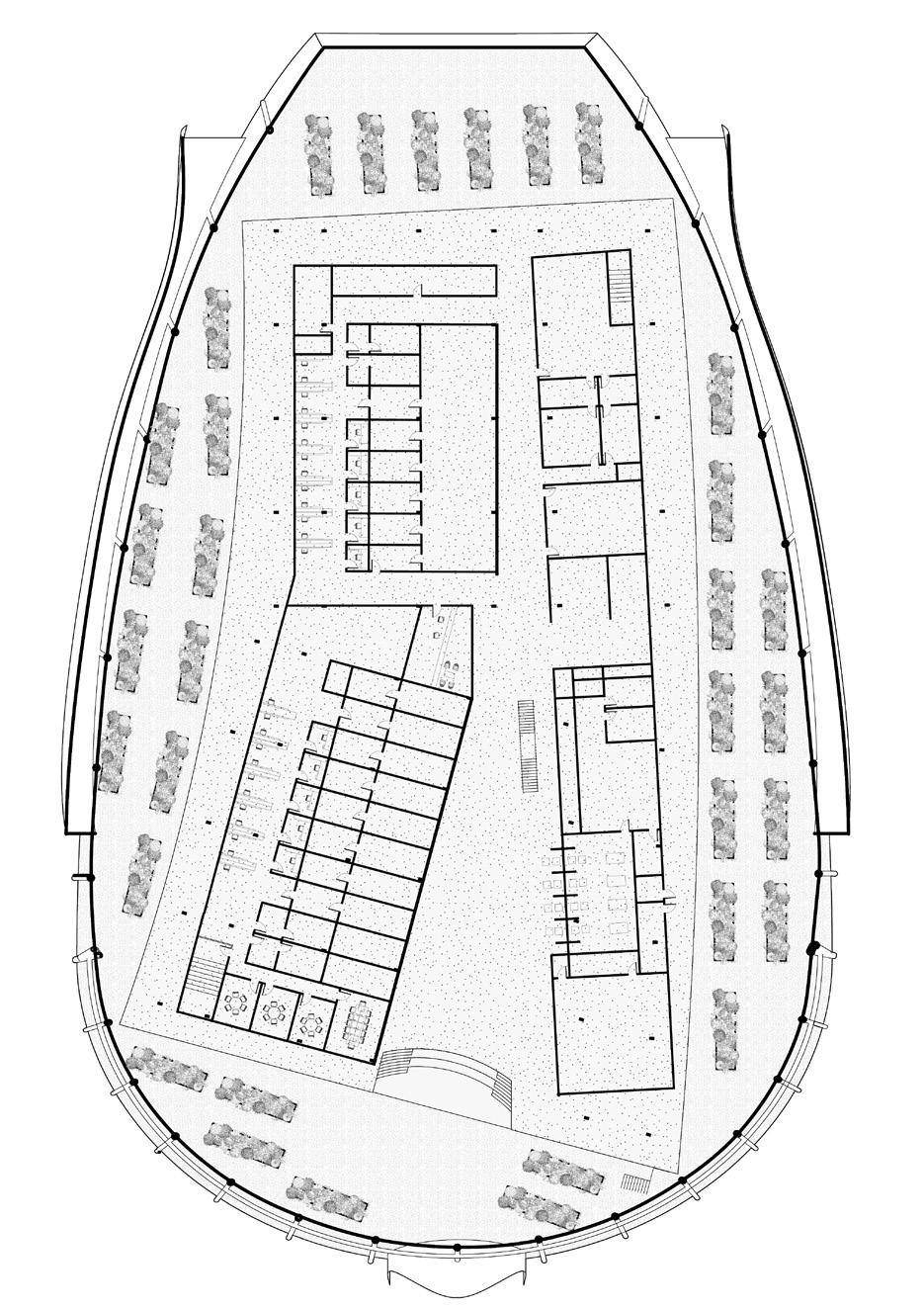
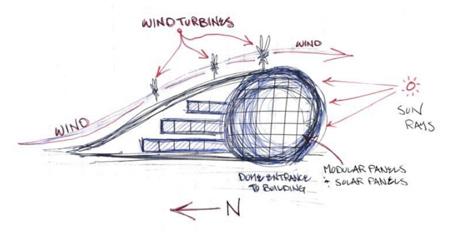
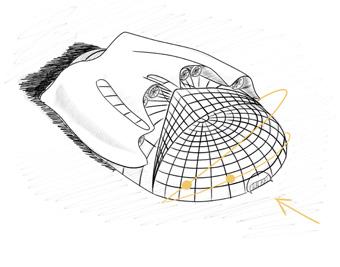

Material and Construction
Methodology

Wind Tunnels
- Fork-shaped to avoid overloading individual turbine under howling winds
- Serves as first layer of insulation

Insulation Walls
- Reinforced concrete structure
- Serves as second layer of insulation
- Included in entire northern facade to withstand winds
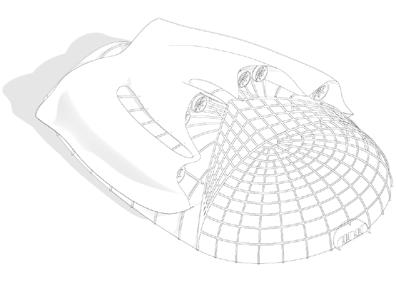
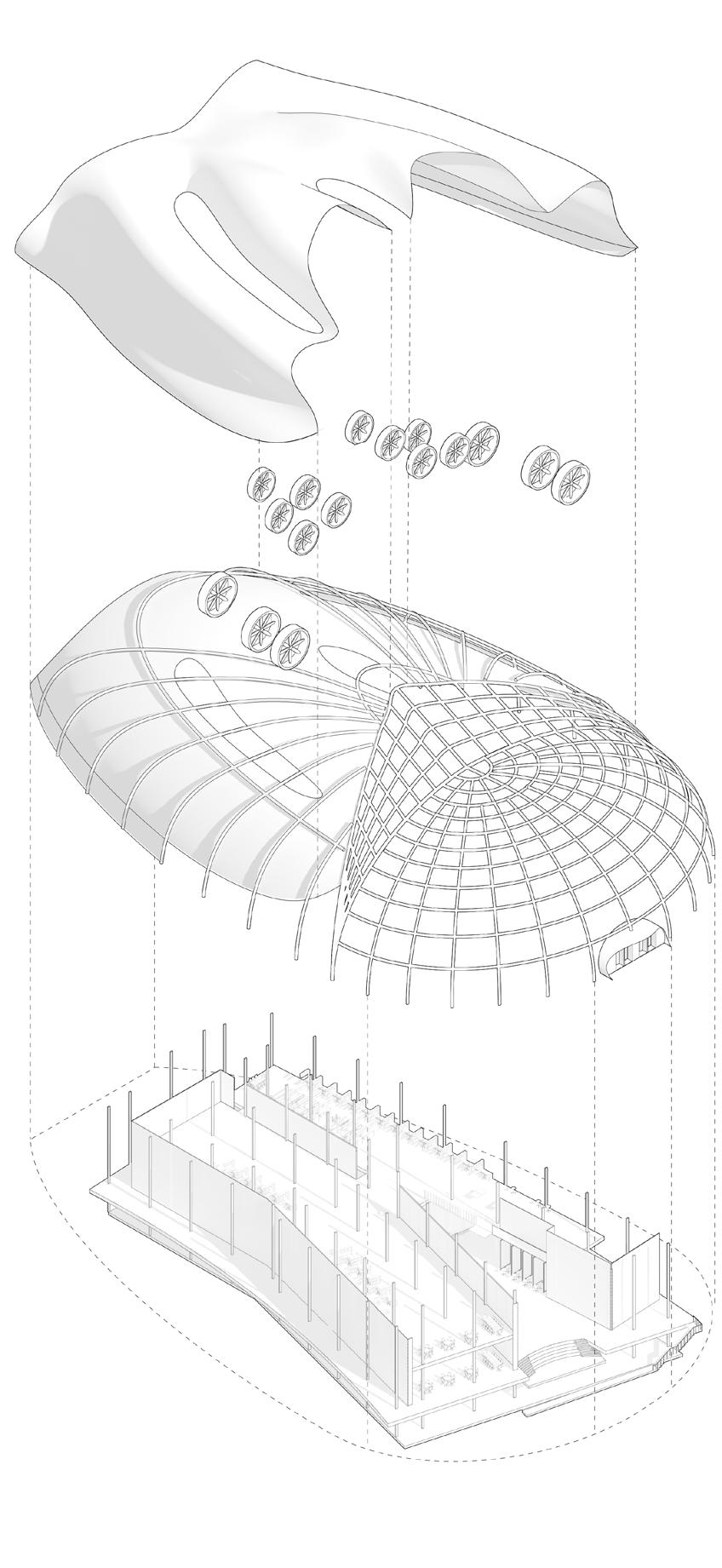

Wind Turbines
- Collect wind power through tunnel
- Main wind directions are North and NorthWest


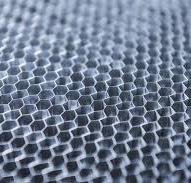

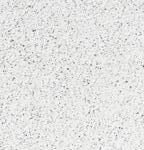
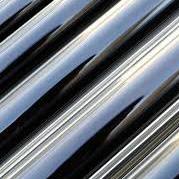
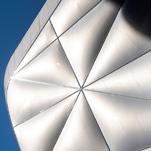
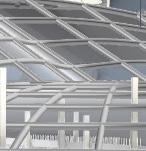
Double Roofs
- Introduction of sunlight
- Stack effect for natural ventilation

Window Panes
- Special materials that can collect solar energy
- Triple-glazed to reduce heat loss
- Glass facade oriented for the Inuvik Sunrise Festival
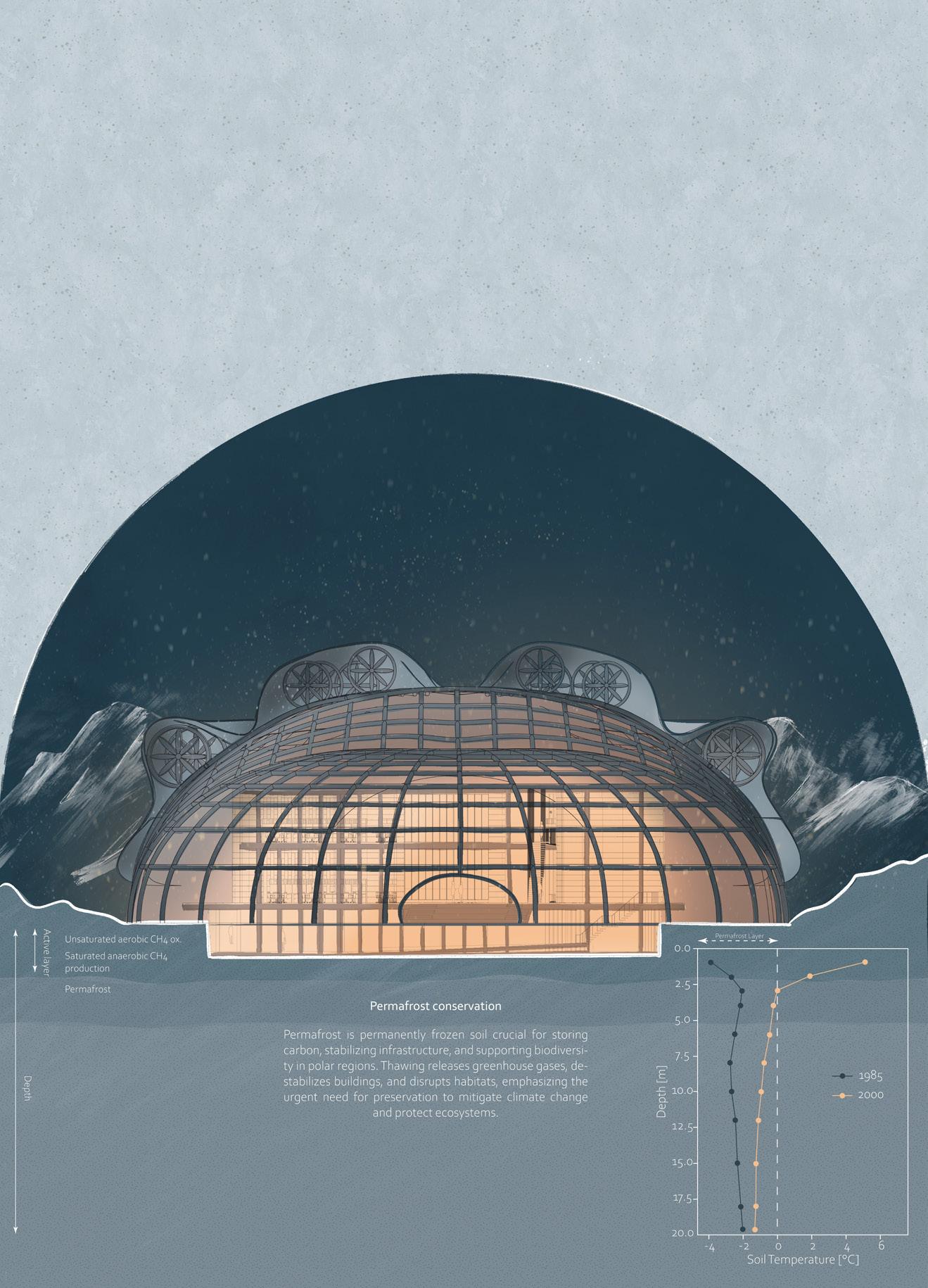
Incorporating materials chosen for their resilience, the selected facade design prioritizes durability and insulation to withstand the harsh climate of Cambridge Bay. Furthermore, modularity in construction ensures ease of assembly and adaptability to the changing needs of the community over time.
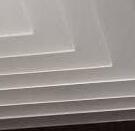

Our project aimed to design a facade for KPMB’s several tests to validate the feasibility of their recommendeddesign. The primary functions of protecting the users from the weather, and generating electricity will be tested, along with the key constraint: ability to be built in a modular fashion.
The power generated from the weather at Cambridge Bay, should exceed 20% of the predicted usage of 97KWh. data which can then be scaled to predict the
power output of the community centre. A wind simulation tunnel tested with average wind speed at the site and a sample wind turbine will produce
Each module will be prefabricated, and then shipped to Cambridge Bay and assembled as a whole structure. They will be attached to structural scaffolding, and connected to other modules via interlocking and securing with fasteners.
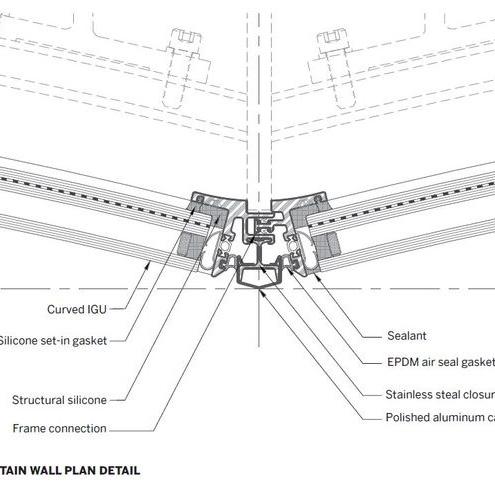
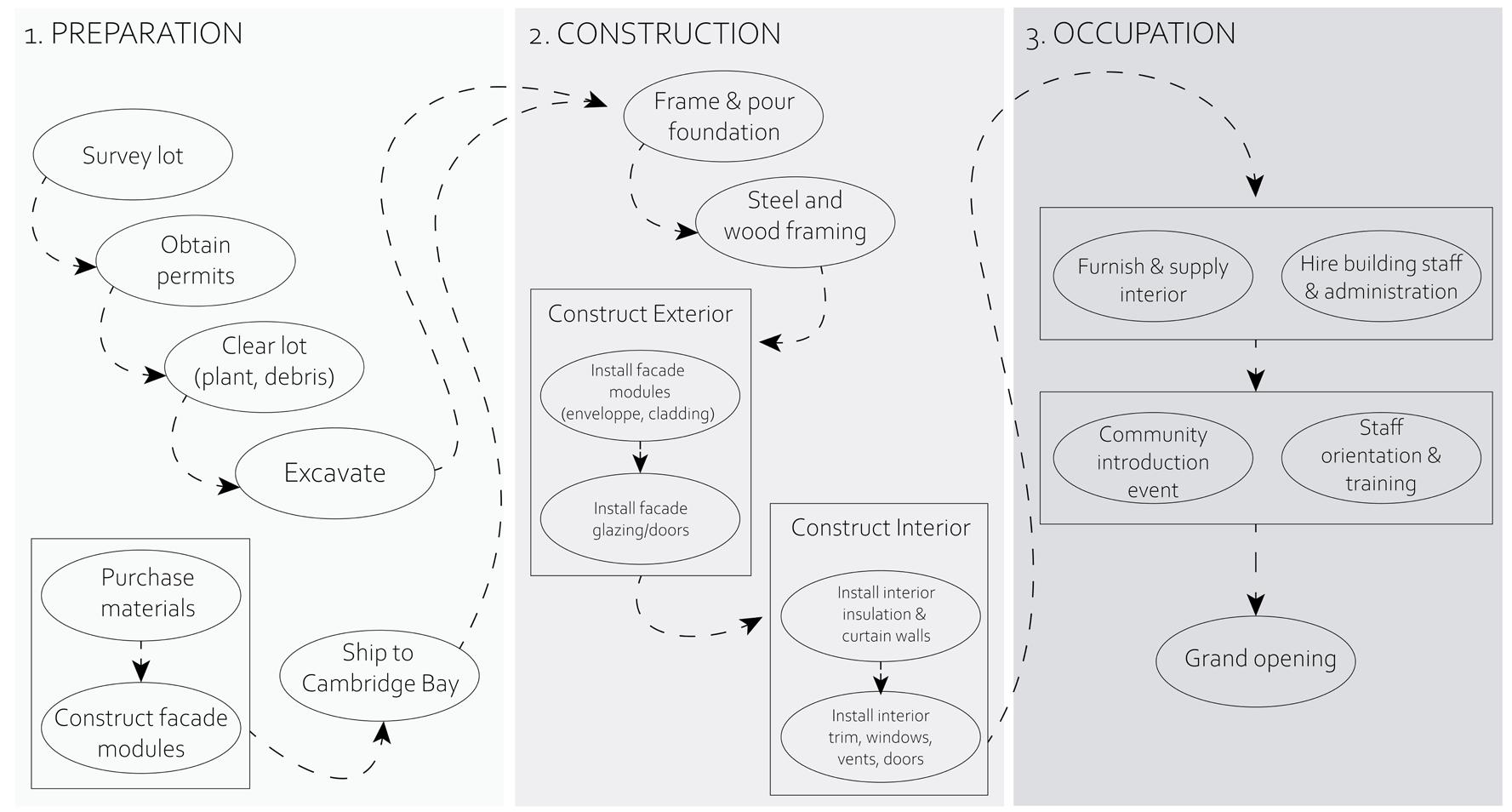


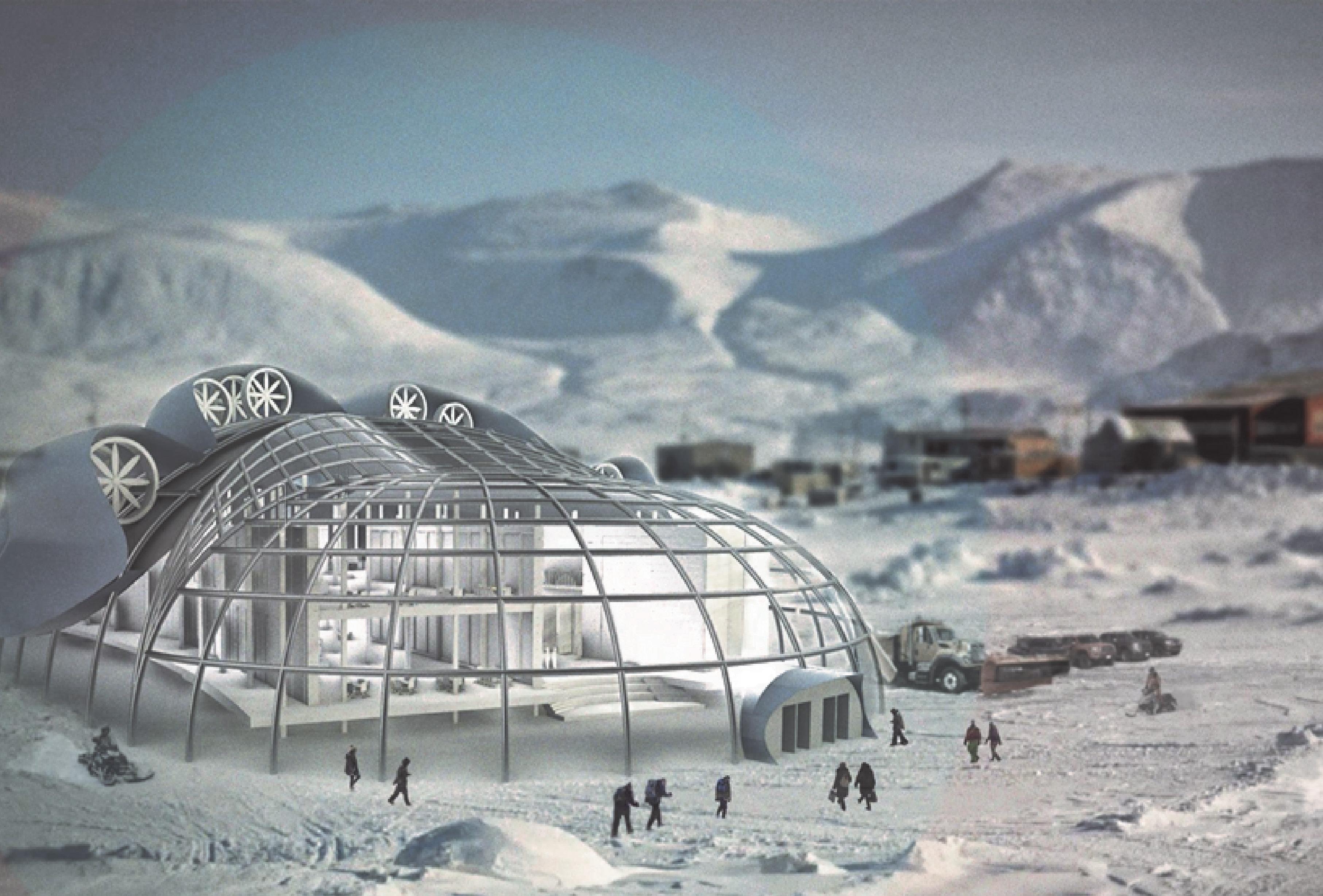



Generates 20.821KWh/m2 of power. A 21.5% decrease in emissions. Aerodynanic. Does not impact permafrost.
Architecture Portfolio 2024